


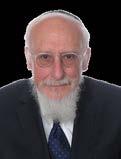

ISSUE 1511 APR 1ST '23 ג"פשת ןסינ 'י PARSHAT TZAV/ SHABBAT HAGADOL PESACH - PARSHAT SHEMINI (SHABBAT MEVARCHIM) ה"ב OU ISRAEL 02-560-9100 | TorahTidbits.com | ADVERTISING 02- 560-9125 ינימש - חספ - לודגה תבש/וצ YERUSHALAYIM IN/OUT TIMES FOR SHABBAT PARSHAT TZAV CANDLES 6:22PM • HAVDALA 7:35PM • RABBEINU TAM 8:15PM חספ חמשו רשכ OU Israel wishes you Chag Kasher Ve'Sameach SignupfortheOUdailysefirahreminderemail@www.ou.org/sefirah Sefirah is the counting of seven complete weeks from the second evening of Pesach until Shavuot. The count, which takes place after nightfall for the following day, is preceded by the blessing only if done in the evening and no days have been missed in the count. Visit www.ou.org/sefirahto receive an email reminder to count each day. Emails are pre-programmed to go out on each of the 49 days of the Omer to help make sure you don’t forget to count! SEFIRAT HAOMER 2023/5783 www.ou.org/sefirah FRI.EVENING EVENING APRIL EVENING APRIL9 MON. TUES. APRIL EVENING APRIL 7 EVENING 13 FRI. SAT.EVENING APRIL 10 EVENING APRIL EVENING 17 TUES. WED.EVENING APRIL 14 EVENING APRIL20 EVENING 21 SAT. SUN.EVENING APRIL 18 EVENING APRIL24 EVENING 25 EVENING 6 NOTE: YOUFORGET COUNTATNIGHT, MAYCOUNT THENEXT WITHOUT BLESSING RESUME THENEXT WITH Sefirat HaOmer: Why Jews Count Rabbi Baruch Taub OU Israel Faculty page 88 Pull Out Sefirat HaOmer Chart pages 56-57 Dear Torah Tidbits Family Rabbi Avi Berman Executive Director, OU Israel page 4
04Dear Torah Tidbits Family
Rabbi Avi Berman
Parshat Tzav- Shabbat Hagadol
08
10
G-d's Protection, Our Responsibility
Rabbi Moshe Hauer
Aliya By Aliya Sedra Summary
Rabbi Reuven Tradburks
16Passing on Our Memories
Rabbi Dr. Tzvi Hersh Weinreb
18Understanding Sacrifice
Rabbi Lord Jonathan Sacks zt"l
22
Shabbos HaGadol: Present
Tense Rabbi Judah Mischel
26Haftorah Insights
Rebbetzin Dr. Adina Shmidman
34Aliya By Aliya Sedra Summary
Rabbi Reuven Tradburks
40Probing The Prophets
Rabbi Nachman Winkler
42Hallel-Spontaneous Praise
Rabbi Shalom Rosner
46Emunah Experience
Rebbetzin Shira Smiles
76Mechirat Chametz and Tevillat Keilim Rabbi Daniel Mann
78Passing on Our Memories
Rabbi Gideon Weitzman
80Erev Pesach: Bi'ur Time For Shemitah Wine And Grape Juice
Rabbi Moshe Bloom
Pesach
28Laws and Customs for Pesach
32Pesach Candle Lighting times
48Citric Acid for Pesach
Rabbi Ezra Friedman
82Torah 4 Teens By Teens R' Yosef Ginsberg // R' Michael Kahn
56
Rabbi Sam Shor
50Simchat Shmuel
Sefirat Haomer Pull Out Chart
66It Will Take Time Rabbi Moshe Taragin
70
Meditative Potential In the Land Rabbi Aaron Goldscheider
74Hallel at the Seder Rebbetzin Zemira Ozarowski
HELPFUL REMINDERS FOR PESACH
84OU Israel Parenting Column Dr. Ethan Eisen
88Sefirat HaOmer: Why Jews Count Rabbi Baruch Taub
94The Y- Files Weekly Comic Netanel Epstein
Parshat Shemini
96Aliya By Aliya Sedra Summary Rabbi Reuven Tradburks
• Latest time to eat Chametz: Wed. morning April 5 - Magen Avraham 10:11 am, Gra 10:35 am
• Latest time to burn/annul Chametz: Wed. morning April 5 - Magen Avraham 11:26 am, Gra 11:38 am
• We eat the Afikoman at the Seder no later than 12:42am
• Tefilat Tal is recited on the first day of Pesach
• We begin to say הכרב ןתו in the weekday Amidah (we stop saying
• On Motzei Yom Tov Rishon we begin counting Sefirat Haomer
• On Shabbat Chol Hamoed the Book of Shir Hashirim is read
REMINDERS FOR THE END OF PESACH
)
• When lighting candles for the last day of Pesach the blessing of Shehechiyanu is Not recited. • Yizkor is recited on the last day of Pesach
• We begin the cycle of Pirkei Avot on Shabbat Shemini (First Chapter)
• Yom Hashoah is observed on Tuesday April 18, 2023
Rosh Chodesh Iyar is on Friday April 21 and Shabbat April 22
2 TORAH TIDBITS 1511 / TZAV / SHABBAT HAGADOL - PESACH - SHEMINI
SHABBAT MEVARCHIM IYAR - PARSHAT SHEMINI םירהצב םיתש ירחא םיקלח רשע השלשו תוקד הנומש ,ישימח םויב היהי רייא שדוח דלומה הבוטל לארשי לכ לעו ונילע אבה שדק תבש םויבו ישש םויב היהי רייא שדח שאר
Table of Contents
םשגה דירומ חורה בישמ
AND HAVDALA TIMES CANDLE
OTHER Z'MANIM
JERUSALEM
Ranges 18 days Wed - Shabbat
Mar. 29 - April 15/ 7-24 Nisan
Earliest Tallit and Tefillin 5:41 - 5:19
Sunrise 6:32 - 6:11
Sof Zman Kriat Shema 9:38 - 9:25

Magen Avraham 9:01 - 8:47
Sof Zman Tefila 10:40 -10:30
(According to the Gra and Baal HaTanya)
Chatzot (Halachic Noon) 12:44- 12:39
Mincha Gedola (Earliest Mincha) 1:15 - 1:11
Plag Mincha
5:38 - 5:46
Sunset (Including Elevation) 7:00 - 7:12
Seymour J. Abrams • Orthodox Union Jerusalem World Center • Avrom Silver Jerusalem College for Adults • Wolinetz Family Shul • Makom BaLev • Birthright • Yachad • NCSY in Israel • JLIC in Israel • Pearl & Harold M. Jacobs ZULA Outreach Center • The Jack Gindi Oraita Program • OU Israel Kashrut
STUART HERSHKOWITZ, PRESIDENT OU ISRAEL
Zvi Sand / Yitzchak Fund: Former Presidents, OU Israel

| Rabbi Emanuel Quint z”l, Senior Vice President | Prof. Meni Koslowsky, Vice President
VAAD MEMBERS:
TImes According to MyZmanim (20 min. before sundown in most cities, 40 min. in Yerushalyim and Petach Tikva, 30 min. in Tzfat/Haifa)
*See page 32 for all Pesach candle lighting times
OU Kashrut NCSY Jewish Action JLIC NJCD / Yachad / Our Way OU West Coast OU Press Synagogue/Community Services OU Advocacy OU Israel
MITCHEL R. AEDER, PRESIDENT OF THE ORTHODOX UNION Yehuda Neuberger, Chairman of the Board, Orthodox Union | Dr. Josh Penn, OU Kashrus Commission

RABBI MOSHE HAUER, EXECUTIVE VICE PRESIDENT | RABBI JOSHUA M. JOSEPH, ED.D. EXECUTIVE VICE PRESIDENT & CHIEF OPERATING OFFICER
Rabbi Dr. Tzvi Hersh Weinreb, Exec. V.P. Emeritus
OU KOSHER: Rabbi Menachem Genack, CEO/Rabbinic Administrator OU Kosher | Rabbi Moshe Elefant, COO/Executive Rabbinic Coordinator ISRAEL: Rabbi Yissachar Dov Krakowski, Rabbinic Administrator | Rabbi Ezra Friedman, The Gustave and Carol Jacobs Center for Kashrut Education/ Deputy Rabbinic Administrator
Headquarters: 40 Rector St. 4th floor, New York, NY 10006 212-563-4000 website: www.ou.org
Editor Emeritus: Phil Chernofsky
Editor: Rabbi Aaron Goldscheider | aarong@ouisrael.org
Advertising: Ita Rochel | 02-5609125 or ttads@ouisrael.org
Website: www.torahtidbits.com
Not getting enough TTs? Too many? None at all?
Contact our DISTRIBUTION 050-577-2111 • ttdist@ouisrael.org
Michael Elman | Yonatan Frankel | Yitchak Fund | Daniella Hellerstein | Stuart Hershkowitz | Jeremy Lustman | Meir Raskas | Atara Reichel | Zvi Sand | Norman Schmutter | Mark Schneider | Esther Williams
RABBI AVI BERMAN, EXECUTIVE DIRECTOR, OU ISRAEL
David Katz, CFO, OU Israel | Chaim Pelzner, Director of Programs, OU Israel | Rabbi Sam Shor, Director of Programs, OU Israel Center Rabbi Sholom Gold, Dean, Avrom Silver Jerusalem College for Adults
22 Keren HaYesod <> POB 1441 <> Jerusalem
9101032
phone: (02) 560 9100 | fax: (02) 561-7432
email: office@ouisrael.org
website: www.ouisrael.org
Founders and initial benefactors of the OU Israel
Center: George and Ilse Falk a"h
Torah Tidbits and many of the projects of OU Israel are assisted by grants from THE JERUSALEM MUNICIPALITY
OU Israel, Torah Tidbits does not endorse the political or halachic positions of its editor, columnists or advertisers, nor guarantee the quality of advertised services or products. Nor do we endorse the kashrut of hotels, restaurants, caterers or food products that are advertised in TT (except, of course, those under OU-Israel hashgacha). Any "promises" made in ads are the sole responsibility of the advertisers and not that of OU Israel, the OU Israel Center , Torah Tidbits.
OU ISRAEL CENTER 3
LIGHTING
SHEMINI HAVDALA TZAV EARLY CANDLES Havdala Early Candles 7:35 Yerushalayim / Maale Adumim 5:40 6:22 7:46 5:46 6:31 7:48 5:49 6:49 7:38 Aza area (Netivot, S’derot, Et al) 5:42 6:40 7:47 5:47 6:50 7:36 Beit Shemesh / RBS 5:41 6:40 7:46 5:47 6:47 7:36 Gush Etzion 5:40 6:38 7:48 5:48 6:48 7:37 Raanana/ Tel Mond/ Herzliya/ K. Saba 5:41 6:39 7:47 5:47 6:48 7:36 Modi’in / Chashmona’im 5:41 6:38 7:48 5:48 6:49 7:37 Netanya 5:41 6:39 7:47 5:48 6:48 7:37 Be’er Sheva 5:41 6:39 7:47 5:48 6:48 7:37 Rehovot 5:42 6:39 7:47 5:48 6:31 7:37 Petach Tikva 5:41 6:22 7:47 5:47 6:48 7:36 Ginot Shomron 5:41 6:38 7:48 5:48 6:39 7:37 Haifa / Zichron 5:41 6:29 7:46 5:46 6:47 7:35 Gush Shiloh 5:40 6:37 7:48 5:49 6:49 7:37 Tel Aviv / Giv’at Shmuel 5:42 6:39 7:46 5:47 6:51 7:36 Giv’at Ze’ev 5:40 6:41 7:46 5:47 6:47 7:36 Chevron / Kiryat Arba 5:40 6:38 7:48 5:49 6:49 7:38 Ashkelon 5:42 6:40 7:47 5:48 6:48 7:37 Yad Binyamin 5:42 6:39 7:46 5:46 6:42 7:35 Tzfat / Bik’at HaYarden 5:39 6:32 7:45 5:46 6:46 7:35 Golan 5:39 6:36 Rabbeinu Tam (J'lem) - 8:15PM • Parshat Shemini- 8:25pm
DEAR TORAH TIDBITS FAMILY
RABBI AVI BERMAN Executive Director, OU Israel
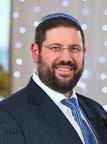
Two weeks ago I spent Shabbat in New York and struck up a wonderful conversation with a couple, during which they asked what is most challenging about my job. I found that my response surprised them.
Most people assume fundraising is the most difficult challenge of leading an organization, especially with the variety of new programs the OU Israel team creates, each of which requires new funds. However, I find that identifying the right staff members who are steeped in Torah, have the sensitivity to recognize areas of difficulties within Klal Yisrael, and commit themselves to creating solutions, is no easy feat. But it is deeply rewarding for all those involved.
My conversation from Shabbat in New York stayed with me, and I referenced it when addressing the students and staff of (םיריעצל םילשורי תבישי( צ"לשי - Yashlatz (Yeshivat Yerushalayim L’zirim) this past Shabbat. Yashlatz is a yeshivah high school connected to Yeshivat Mercaz HaRav (founded by Rav Kook in 1924). The high school was founded by Rav Avraham Shapira in 1964, providing students with access to prominent leaders in the dati leumi community, including Rav Binaymin Eisner a”h, Rav Shmuel Eliyahu, Rav Avram Ramer zt”l, Rav Chanan Porat
zt”l, Rav Elisha Vishlitsky zt”l, Rav Shlomo Aviner, and many more.
With its rich history and stellar educators, Mercaz HaRav has molded many leaders who have since impacted the spiritual growth of Am Yisrael. I am fortunate to know and learn from many alumni from Yeshivat Mercaz HaRav, and even work beside them. Harel Chetzroni, founder of The Zula shel Chetzroni, otherwise known as OU Israel’s Pearl & Harold Jacobs Zula Outreach Center, attended Yashlatz and fondly recalls the warmth and love with which he was received at the yeshiva.
Surrounded by Torah giants, Yashlatz and Mercaz HaRav students have themselves proven to be special individuals. We learned this most painfully after the Mercaz HaRav massacre which took place on Rosh Chodesh Adar Bet 5768, during which six boys from Yashlatz and two young men from Mercaz HaRav were killed while learning in the library. The stories that were told about these holy souls following their deaths have continued
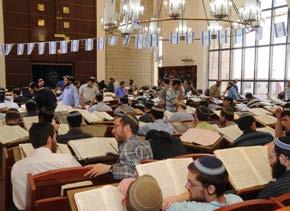
4 TORAH TIDBITS 1511 / TZAV / SHABBAT HAGADOL - PESACH - SHEMINI
ה"ע בקעי תב האל הרש נ"על Sylvia Feldman a"h ח"משת ןסינב ט"י 35th Yahrzeit
in
& Greenblum Families
Always
our hearts Feldman
to serve as inspiration for what it means to live a life committed to Torah learning and dedicated to the Ribono Shel Olam.
With tremendous respect for the impact that Yashlatz and Mercaz HaRav continues to have on Am Yisrael, my wife and I were thrilled when our sons Meir, Tzvi Yehudah, and Yechezkel chose to attend Yashlatz, and have found the experience to be very rewarding for each of them. As is Yashlatz tradition, the high school hosts a Shabbat Horim for parents of 12th graders. With our son Yechezkel in this year’s graduating class, my wife and I joined the Shabbat Horim this past week, and experienced a ‘Shabbat in the life of a Yashlatz student.’ Needless to say, as beautiful as the experience was, I don’t miss dormitory life!
I was asked to speak on Shabbat morning and began by addressing the staff on behalf
their upcoming Yahrzeits: Russell Jacob Mayo z"l

8 Nisan 5780





Roland Shmuel Mayo z"l
17 Nisan 5755

Isaac (Frank) Mayo z"l
21 Nisan 5781
May their Neshamot have an Aliyah in Shamayim. We sorely miss them!

Love Always, Roger Yosef Mayo

Richard David Mayo

OU ISRAEL CENTER 5 True wholesaler from the diamond boursa with over 25 years experience member diamond dealers club Engagement Rings ∙ Stud Earrings Pendants ∙ Tennis Bracelets 050-573-9061 jeffmor36@gmail.com www.JeffMorDiamondJewelry.com
In loving memory of my brothers, Russell and Roland Mayo and my father, Isaac Mayo on
of the parents of this year’s graduating class. I explained that parents and teachers have the daunting task of raising HaShem’s children. Together, we have the opportunity to mold ovdei HaShem and must work side by side in helping each and every child reach their potential. Under the tireless efforts of the Yashlatz teachers and staff, my boys have grown tremendously and I believe have been given the tools they need to contribute to the world around them.
I then turned my attention to the students and recounted the conversation I had the Shabbat prior with the couple in New York and noted the opportunity that each student now has. I was deeply moved to learn over the course of Shabbat that most of my son’s friends will be leaving Yashlatz to study in yeshivot around the country before enlisting, while others will begin mechina
programs following graduation.
Addressing these students who have been cocooned in a world of Torah learning and will soon leave the yeshiva environment to enlist in the IDF, I felt it important to emphasize that each of them has what it takes to become a leader and represent what it means to be an eved HaShem wherever they find themselves after graduation. But in order to make a difference in the world around us we must first acknowledge the kochot we have been given and continue to develop those areas within ourselves.
I therefore encouraged the students to think about ways they can utilize the kochot they developed under the tutelage of Yashlatz and apply them to supporting the future of Am Yisrael. After welcoming in Rosh Chodesh Nissan this past week, a time of rebirth and hope, my bracha is that we each identify the potential within ourselves, tap into the power of renewal, and unify in a mission to love and support one another.
Be’ezrat HaShem, naa’seh v’natzliach! (With the help of G-d we should do and we should succeed!)

Wishing you all an uplifting and inspiring Shabbat and Chag Kasher V’Sameach,
Rabbi Avi Berman Executive Director, OU Israel aberman@ouisrael.org

Condolences to Mrs. Rickie Rabinowitz and family on the passing of her mother
Mrs. Paula (Perel) Nussbaum
6 TORAH TIDBITS 1511 / TZAV / SHABBAT HAGADOL - PESACH - SHEMINI
a''h םילשוריו ןויצ ילבא ראש ךותב םכתא םחני םוקמה
Lasik Consultations - Eye Exams Eye World Be it H an at zi v –1 01 D er ec h He vr on Optometrist (Canada, USA) Ph on e: 0 2- 67 4- 38 88 Forme rl y at B el l Op ti ca l, J er us al em an d La si kM D, Tor on to D R . E ZRA F RANKEN Maccabi and Meuchedet benefits
עבשו םייתאמ ?עדוי ימ
600+ bocherim in Eretz Yisroel assisted with army issues
$3,000,000+ funded for global Jewish causes
50+ seminaries assisted with programing and trips
Did you know that Eretz HaKodesh has partnered with 207 mosdos, Yeshivos, Seminaries, Kollelim, Neshei Groups and other organizations this year?
100+ yeshivos assisted with services, mesibos and events
$150,000 +
for career training for hundreds of Chareidi American women living in Eretz Yisroel
₪30,000,000+ secured for programs for struggling teens
350+ families of children with special needs serviced
10,000 + Chareidi youth participated in Shmitah events
The kedusha of Eretz Yisroel and Torah are eternally bound. Together, let’s make sure that Eretz Yisroel remains Eretz HaKodesh.
As you learn about some of the good we’ve done, imagine how much negative we’ve prevented.
WWW.ERETZHAKODESH.ORG
ENSURING THAT ERETZ YISROEL REMAINS ERETZ HAKODESH
OU ISRAEL CENTER 7
…ונילע םוקמל תלפכמו הלופכ הבוט המכו המכ תחא לע ...לארשי ץראל ונסינכהו הרותה תא ונל ןתנו
RABBI MOSHE HAUER OU Executive Vice President


G-d's Protection, Our Responsibility
Protection and security are recurring themes around Pesach. The name of the festival itself – Pesach - recalls how Hashem protected the Jews, passing over our homes as He struck the Egyptians. That security extends to the present, making it customary that on seder night - the leil shimurim (night of protection) - we lessen our manmade protections by not double-locking our doors or saying the full bedtime shema (see OC 481:2, Magen Avraham). The mezuzah that adorns our doorposts and safeguards our homes year-round commemorates the security attained by the original placement on our doorposts of the blood of the Pesach (see Ramban Shemos 13:16).
This is a concept we may struggle to relate to as Jews everywhere experience a feeling of enhanced vulnerability. Can we really see this as a night and a season of protection? This is a hard question that we can attempt to address, not to answer.
The aspect of divine protection is only one facet of the leil shimurim. As Ibn Ezra and Ramban (Shemos 12:42) noted, the shmira of which we speak, besides describing Divine protection we received,
refers as well to shmiras mitzvos, our own safeguarding and observance of the many mitzvos connected to Pesach. The critical food of the evening is matzah shmura, matzah that we must protect from leavening throughout its preparation. What we experienced that night was something that we do not merit to see in a visible manner in our day-to-day lives, as our shmiras mitzvos(observance) invited G-d’s shmirah (protection) in response.
This is also the known theme of Shabbos HaGadol, commemorating the Shabbos preceding the Exodus when we observed G-d’s command to set aside the Pesach offering despite its exposing us to the wrath of the Egyptians. The greatness of this Shabbos lies in this miracle of reciprocity, of G-d extending His protection to those who stood up to safeguard His command.
We must not be simplistic and expect to see in our world that elegant correlation between our actions and our fate. The miracles of the Exodus were singular in history and have yielded to a life where bad things seem all-too-frequently to happen to very good people. Yet in the shadows of the search for an elusive appreciable reciprocity lies the opportunity to fulfill our clear responsibility, to do good for G-d, to safeguard that which is precious to Him, until that day soon when – as we did when we left Egypt – we will be able to see so clearly how He has been caring for us.
8 TORAH TIDBITS 1511 / TZAV / SHABBAT HAGADOL - PESACH - SHEMINI FROM
THE DESK OF
SHABBAT HAGADOL
but you could possibly do them. For when it comes to communications from G-d, you are unique, irreplaceable, sui generis, one of a kind.
This exchange presents a fundamental principle of the Torah: that G-d speaks to Moshe in a way that He does not, nor will He in the future ever do again with anyone else. When Moshe says that people come to him seeking G-d, what he means is: I have access to G-d. He speaks to me. (Speaking to G-d isn’t the trick; the trick is when He answers back.) Similarly, when Moshe says that he teaches G-d’s law, what he means is that G-d communicates those laws to him and to no one else.
This could very well be the prime purpose of this Yitro story. For, in the very next story, the giving of the Torah, the very same theme of Moshe’s uniqueness as the one to whom G-d speaks is central.
3rd aliya (18:24-27) Moshe heard. He chose judges, with only the most difficult cases brought to him. Moshe sent Yitro home.

It takes an honest leader to accept suggestions to improve. Moshe displays his honesty and humility – if the suggestion is good, embrace it. Just as Yitro accepted the news of the Exodus and affirmed One G-d,



Owning your own apartment does not just allow you freedom, but offers monetary savings, and an increase in your investment value. Anglo-populated, sunny Ashkelon is the answer! It’s very affordable – from $500,000 with just a 15% down payment, mortgages available as well as bank guarantees. Rental income often in excess of 3.5%.


Keren Malki empowers families of children with special needs in Israel to choose home care. Donations are tax-approved in Israel, US and UK.


kerenmalki.org
02-567-0602
Honoring the memory of Malka Chana Roth ד”יה 1985-2001, killed in the Sbarro bombing.

OU ISRAEL CENTER 9
MarSea Modest Swim & Casualwear www.MarSeaModest.net (NIS) www.MarSeaModest.com ($USD) Marci Rapp 050-424-8359 THE BEST DESIGN, ENGINEERING AND INSTALLATION OF AIR davidz@AshkelonProperties.com LIVE OPPOSITE THE SEA 0544-332621 said another happy client Ashkelon for only 15% down – is actually a reality.”
LIVE OPPOSITE THE SEA davidz@AshkelonProperties.com call David at 054-433-2621 www.ashkelonproperties.com ashkelon properties וניד our exclusive sea-front properties had only been proven to be an excellent investment – only 15% down IF it would be enough וניד our properties were only to earn about 3.5% rental money while you’re away our properties were only offering very favorable mortgages and extremely solid bank guarantees וניד it would be enough it would be enough וניד IF IF MASSAGE THERAPIST & FITNESS TRAINER 052.673.3704 I www.andyhealth.com | jerusalemmyhome@hotmail.com TUVIA ANDY HAAS BALANCE and FALL-PREVENTION SPECIALIST for OLDER ADULTS Maintain Healthy Bones and Muscles Decrease Stiffness and Joint Pain Increase Strength! Stay Independent!
KI TEITZEII
SHABBAT HAGADOL TZAV
ALIYA-BY-ALIYA SEDRA SUMMARY
Rabbi Reuven Tradburks Director of RCA Israel Region

1st aliya (Vayikra 6:1-11) Instructions are given to the Kohanim: while the offerings must be done during the day, the burning of the fats and limbs continue all night. In the morning the Kohen shall take some of the ashes from the altar and place them at the side. This pile of ashes is removed to outside the Mikdash. A fire for the offerings is to burn constantly. When a Mincha flour offering is brought, part is burned on the altar, the remainder eaten by the Kohanim. It may not be chametz.
Parshat Vayikra outlined the Kohen’s work; in Tzav it is the Kohen’s menu. But before that, day and night of the Temple is presented. The Jewish day begins at sunset: evening and morning, one day. But not in
the Temple. The day in the Temple was the opposite; day followed by night, one day. Offerings are brought during the day and burned through the night. With dawn, a new day begins.
The offerings have time limits. Most offerings must be burned and the Kohen must consume his parts in a day – meaning the day they are brought and the night that follows. Some have 2 days. And the offering we are most familiar with (as we are all the wise child of the seder), the Korban Pesach may be eaten only at night, and perhaps even only until midnight. As we learn the rules of offerings we realize how unusual the Korban Pesach is in all of its rules.
2nd aliya (6:12-7:10) A special Mincha flour offering is brought by a Kohen on the first day of his service, by a Kohen Gadol on the first day of his service and daily by the Kohen Gadol. It is boiled, then baked and completely burned. When a Chatat, a sin offering, is brought, it is consumed by the Kohanim in the Temple. The utensils used to cook it must be kashered; while a metal utensil can be put in water, an earthenware one must be broken. An Asham, sin offering, is also consumed by the Kohanim in the Temple. For an Olah, the Kohen receives the leather. The Kohen consumes baked Mincha offerings.
When and where the Kohen or owner consumes the offering varies according to the offering. The “kodesh kodashim – the holiest of holy” offerings are consumed in the Temple grounds itself. That includes the Olah, the Chatat and the Asham. These are offerings brought to express a submission to G-d; the owner does not consume any of
10 TORAH TIDBITS 1511 / TZAV / SHABBAT HAGADOL - PESACH - SHEMINI
תמשנ יוליעל ל''ז קנומ ןהכה והילא Eliyahu Hacohen Munk z"l On his first yahrzeit ןסינ ג''י Missed by his wife, Greta Munk His children, grandchildren and great-grandchildren
and our next step will be to plant a fruit tree. I never thought of myself as being the agricultural type, but the feeling of settling and planting a portion of Eretz Yisrael, has been truly euphoric. Iy”H, when we plant our tree, and eat the fruits that will grow one day, I think we will be able to truly appreciate that unique Kedusha found in the fruit of Eretz Yisrael!
it, has no personal pleasure in it. An Olah is completely burned, save the leather, which is given to the Kohanim.

Here we have the first mention of kashering utensils. Kohanim would have 3 types of utensils: milk, meat and kodshim, utensils used for offerings. Once the time limit for eating the offering expires, the utensil becomes non kosher and must be kashered. If it is earthenware, it is not able to be koshered. Earthenware is like disposables – chad paami, one time use only. Little wonder that areas in which offerings were brought are treasure troves of broken pottery for archaeologists; for those pottery utensils would be used once and never again.
To conclude, when you buy your Tu B'shvat fruit this year, don’t search for those dried apricots and banana chips imported from Turkey. Rather, head over to the fresh produce and buy yourself some nice juicy Kedusha-filled Jaffa oranges and thank Hashem for bringing you to this land in order to be able to הבוטמ עבשלו הירפמ לוכאל, imbibing that Kedusha in every bite that you take!!
3rd aliya (7:11-38) When a Shlamim, a peace offering is brought to express thanks, 10 mincha breads each of 4 different types are brought. One of each of these 4 types is given to the Kohen. The owner consumes the offering over 2 days. He may not be Tameh, impure. Blood and the offered fats may never be eaten. The Kohen is given the breast
May the Torah learning from this issue of Torah Tidbits be תמשנ יוליעל
Leila Manasseh z"l
ל"ז הקבר היחו יבצ תב החונמ האל On her first Yahrzeit
ןסינ ד"כ

Greatly missed by her children, grandchildren and great grandchildren
Debbie & Howard Ross, Francesca & Iain Miller, Honey & Benyo Lipnick and Darren & Michal Manasseh
OU ISRAEL CENTER 11 OU ISRAEL CENTER 75
and thigh of the shlamim offering.
The Shlamim is a new category of offering. It is eaten by the owner. It is not restricted to the Temple; it may be eaten anywhere in Yerushalayim. And, the owner has 2 days to consume it. The city of Jerusalem must have been filled with mikvaot, not just for the Kohanim who were going up to the Temple, but for the celebrants, bringing their shlamim, who would need to consume their offerings in a state of Tahara, purity. And there must have been hotels that had special OU Kodshim supervision – special utensils only for kodshim, for cooking offerings. Those bringing shlamim were thankful, joyful, people winked upon by G-d – my, the city of Jerusalem must have been filled with smiles.
4th aliya (8:1-13) Moshe is instructed to inaugurate the Kohanim. Moshe gathered the people and the Kohanim, pronouncing that the following has been commanded by G-d. Moshe dresses Aharon in the garments of the Kohen Gadol. With the anointing oil he anointed the Mishkan, the altar, and Aharon. He dressed the Kohanim in the Kohen garments, as commanded by G-d.
The instructions for inaugurating the Kohanim were given in Parshat Tetzaveh; the inauguration occurs here. The last 4 aliyot of this parsha all end with the same phrase: as G-d commanded. Perhaps this is to avoid accusations of nepotism. Moshe is not appointing his brother as Kohen Gadol in the way politicians hand out jobs to family and supporters. Moshe was commanded.
This phrase is also foreshadowing. Next parsha Nadav and Avihu will do something
they were not commanded, a noteworthy departure from all the loyalty of Moshe and Aharon until here.
5th aliya (8:14-21) Moshe brings the inauguration offerings. The Kohanim place their hands on the Chatat, the sin offering. Moshe offers it; the blood is placed on the altar, the fats burned, the animal burned outside the camp. The ram as an Olah is offered; the Kohanim place their hands on the head, Moshe does all of the procedures for its offering.
Moshe acts as the Kohen for the entire inauguration ceremony. He does the slaughter, the sprinkling of the blood, and the offering of the fats. Perhaps this is to sensitize Aharon and the Kohanim to “the other side” of the process. Experiencing what it is like to have someone bring your offering for you will allow you to perform the bringing of offerings with greater sensitivity. Because, now you know how it feels to be on the other side.
6th aliya (8:22-29) The second ram, the Inauguration Ram is brought. Moshe places its blood on Aharon’s right ear, right thumb and right big toe. And does the same for the Kohanim. He offers the ram, sprinkling its blood, burning the fats and offering on the
12 TORAH TIDBITS 1511 / TZAV / SHABBAT HAGADOL - PESACH - SHEMINI
In loving memory of our dear mother, grandmother and great-grandmother
חספ לש יעיבש
DOROTHY WEINER a"h On her 18th Yahrtzeit
Rena & Zev Lewis Heschel & Sarelle Weiner
been memorialized in a popular song, "An eternal people does not fear the long and arduous path."
be in loving memory and נ"על our dear parents whose yahrtzeits are in Kislev
Doris Weinberger a"h

ולסכ 'ד -ה"ע המלש לאקזחי תב האל הרובד

altar one each of the matzot brought with it after Aharon and the Kohanim waved them. Moshe waved the breast, his portion in the offering.
Max Weinberger z”l
ולסכ ז"כ -ל"ז בד ןב ךלמילא
Greatly missed by their children, grandchildren and great grandchildren
Rav Aryeh and Dvora Weinberger
Bernie and Leah Weinberger
Patience is necessary for those who follow Isaac's way. But a wise woman taught us that patience is but another name for hope. That woman was Jane Austen, who put these words into the mouth of one of the characters in her great novel, Sense and Sensibility: "Know your own happiness. You want nothing but patience—or give it a more fascinating name: call it hope."
Menachem and Hannah Katten
In observance of the Shloshim of our friend
Yehuda Leib Berren z"l
With this offering, the position as official Kohanim of the Jewish people is inaugurated. There are no other Jews, as far as I am aware, who can trace their lineage as far back as Kohanim and Leviim. A Levi today descends from Levi, the son of Yaakov. And a Kohen descends from Aharon, brother of Moshe. That Kohen status begins at this moment in the desert, one year after the exodus from Egypt and continues, unbroken, til today.
Rav Menachem Weinberg will give a shiur in his memory "Heroic Joy"
Monday evening, 23 November/ 8 Kislev
7:30pm
Zoom Meeting: 853 8980 1519
Password: Yehuda
7th aliya (8:30-36) Moshe instructs Aharon to cook the meat of the offering and to consume it and the matza. The Kohanim are not to leave the Mikdash for 7 days. This same procedure is to be done when gaining atonement. Aharon and the Kohanim did all that G-d commanded.
Our parsha outlined some of the benefits to the Kohen, due to his holy service. Support of clergy, or spiritual workers, or ritual leaders is a universal notion, crossing cultures and religions. Our Kohanim are no different in receiving such benefits. However, far more important is not what they receive, but what they do not.

Back in the Yosef story we are told how the Kohanim in Egypt, the Egyptian clergy were treated. They received public support of food. They had land. All of the land of Egypt was taken by Paro in payment for the food during the famine; save the land of the priests. The wealthiest people in Egypt were the priests. In our time, the wealth of the Vatican is vast.

OU ISRAEL CENTER 13
OU ISRAEL CENTER 15
052-385-9944 • 054-499-9043
SEALING SERVICES
ARNONA/TALPIOTBeit Hanatziv, Derech Hevron 101A RAMAT ESHKOL Shopping Center (Above Waffle Bar) (02) 674-3888 guarantee • Contact lenses • Beautiful frames It’s not only how you LOOK It’s how you SEE
SEALING SERVICES AND ROOFING shmuelnathan4@gmail.com
Our Kohanim, in contrast, have no land; nor do the Leviim. They receive support, albeit modest. This is another instance of the Torah’s moderation; supporting the Kohanim, though modestly. The King will receive similar instructions; benefits but with limits. Leadership is serving G-d and His people, not self serving. When reading the Torah we need to notice not only what is said but what is not said; what rights are given, but more importantly what rights are not given. The Kohanim receive; but modestly.
HAFTORAH TZAV/ SHABBAT HAGADOL MALACHI 3:4-24
The Shabbat before Pesach is referred to as Shabbat Hagadol, or The Great Shabbat. Though it is not absolutely certain why Shabbat HaGadol was given this name, some suggest that it is based on a pasuk at the end of the haftorah of this Shabbat.
A day will come in the future, says that prophet, that will be ‘gadol’, or awesome. “Lo, I will send the prophet Eliyahu to you before the coming of the awesome, fearful day of the Lord.” (3:23)
The message of Malachi is clear: The people have been committing various sins. He warns the people that there will be a day of reckoning. Every act, every word, we engage in is judged by God. Now is the time to return.
There is a subtle hint in the haftorah to our celebration of the Seder with the reference to the coming of Eliyahu Hanavi. The haftorah ends with a reference to Eliyhau who will come at the end of days to herald the coming of the Mashiach. An uplifting message tops off the haftorah. In the final pesukim the powerful notion is conveyed that just as the people of Israel were redeemed from Egypt after generations of slavery, so too will the people be redeemed with the coming of the Mashiach in the time to come.
May that day come soon be”H!
A SHORT VORT
In the Haftorah for Shabbat Hagadol we read from the words of the Prophet Malachi.
“Remember the Torah of Moshe My servant, which I commanded him in Chorev for all Israel, both statutes and judgements. Behold, I will send you Eliyahu HaNavi” (Malachi 3:22)
It would seem from the onset that Malachi, the last prophet, is ending his writing with a caution to the Israel nation to remember the Book of Moshe- the Torah, in order to merit redemption.
However, the Chofetz Chaim (Rabbi Yisrael Mayer HaCohen 1839-1933) emphasized the words used by the prophet: “for all Israel”. This means that only when we ALL as one nation, UNITED together, remember the Book of Moshe – the Torah and adopt its moral and ethical ways, will G-d keep his word and usher in Elijah the Prophet who will herald in the redemption.Shabbat Shalom and Chag Kasher V’Sameach
14 TORAH TIDBITS 1511 / TZAV / SHABBAT HAGADOL - PESACH - SHEMINI
18 mitzvot; 9 pos. and 9 prohibitions
MITZVOT
BY RABBI
R av, Beit
CHANOCH YERES
Knesset Beit Yisrael, Yemin Moshe
איבנה הילא תא םכל חלוש יכנא הנה .םיטפשמו םיקוח לארשי לכ לע ברוחב ותוא יתיוצ רשא ידבע השמ תרות ורכז (גכ-בכ:ג יכאלמ)
Mazal Tov to Dr. Harvey & Rivka Woolf and family on the Bar Mitzvah of their son, Amitai
• Curtains & draperies
• Designer curtains
• Venetian & Woven wood blinds
• Blackout, Vertical, Roller, Roman & Pleated shades

JERUSALEM SALES
EXCITING PROJECTS, BUILDINGS
Presales and immediate occupancy
BUILDINGS AND VILLAS
In the most desirable neighborhoods
FOR SALE
OLD KATAMON
Exclusive! New! 160 sqm, 4 bedrooms, 3 bathrooms, garden 26 sqm, storage, parking, close to the Shtibelach. Occupancy within 1.5 years NIS 9,200,000
SHAAREI CHESSED / RECHAVIA
Renovated 110 sqm 3 bdrms, 1st floor, succah.
Beautiful 3 bdrm apt + 50 sqm succah balcony, shabbat elevator, parking and view.

New 228 sqm duplex penthouse, 30 sqm succah balcony, shabbat elevator, parking and a view.
TALBIEH all on private land
Spacious 2 bdrms, 114 sqm, succah balcony, shabbat elevator, storage room, parking, built on a high standard
Renovated 3 bdrm, 130 sqm, succah, elevator, storage room, parking!
Magnificent 250 sqm + 200 sqm registered garden
BAKA Spacious 2 bdrms, 85 sqm, 1st floor, succah, parking, future Tama
TALPIOT
4 rms, balcony, elevator, machsan, parking, view.
NACHLAOT
Renovated 2 rms, private entrance, storage room, NIS 2,350,000
HAR NOF
Central! 3 bedrooms, renovated, storage room!
4.5 rooms + permit for 40 sqm expansion on the terrace, 3 exposures, storage room.
Central! 120 sqm + rental unit, lovely patio!
Price reduced! 140 sqm apartment facing an open view! large storage room.
www.ashleywilde.co.il

02-651-4030

OU ISRAEL CENTER 15
Eiferman Properties Ltd. www.eifermanrealty.com
FOR MANY MORE PROPERTIES:
-
NEW LISTINGS
SHABBAT HAGADOL
BY RABBI DR. TZVI HERSH WEINREB OU Executive Vice President, Emeritus


Passing on Our Memories
Our Sages tell us that we were redeemed from Egypt on the merit of the righteous women. The men in Egypt were enslaved, both physically and mentally; their morale was extremely low, as it seemed that there was no hope and no prospect of ever leaving Egypt. In addition, Paro had given the midwife's explicit instructions to kill all the male children, and, when they disobeyed his orders, he simply commanded his servants and soldiers to go and find Jewish male babies and kill them.
Jewish men were distraught, asking themselves whether it was even worth it to continue having children, who would inevitably die at the hands of their cruel Egyptian masters. They separated from their wives, stopped having children, and waited for the fateful demise of the Jewish
people. Had the men had their way this would be the end of the children of Israel, who would have perished before we could become an independent nation.
But the women had a different attitude; they were not willing to surrender to the evil decree, they refused to succumb to the sadistic ruler of Egypt. They enticed their husbands and continued to give birth to boys and girls. Many were killed and some were able to get away, but the Jewish people as a whole survived, due to the tenacity and determination of Jewish women.
While the Midrashic story highlights the achievements and unswerving faith of our incredible Jewish women, it also emphasizes that the future of the Jewish people is dependent on the birth of Jewish children. Without babies being born the Jewish people cannot survive.
This is the reason why Seder night is centered on children, and on passing the tradition from one generation to the next. The Torah instructs us "and you shall tell
16 TORAH TIDBITS 1511 / TZAV / SHABBAT HAGADOL - PESACH
THE PERSON IN
PARSHA
- SHEMINI
THE
your children on that day, saying, because of this God did for me when I left Egypt" (Shemot 13:8). Seder night is about the importance of children for the continued survival of the Jewish people. It is a multi-generational experience in which the focus is on telling the new generation about the past generations, making our memory their memory.
At this time, we can give thought and prayer for couples facing fertility challenges and are currently unable to tell their chil dren the story. We can show them sympathy and empathy, and, when appropriate, we can say a few chosen words. As we enjoy our families and tell our children and grandchil dren the story, we can remember those who cannot yet pass on the tradition, that soon they will tell children of their own.

Pesach Sameach

OU ISRAEL CENTER 17
054-527-9356 DIRTY AIR, DAMP & MOLD GREEN TREATMENT EXPERTS - Corona Cleaning - Deodorization - Leak Detection Systems - Waterproofing - English + Hebrew Reports - Working at heights - Insured - Quality House Painting QUICK ESTIMATE/FREE ADVICE :) 058-444-1270
COVENANT & CONVERSATION
Understanding Sacrifice
One of the most difficult elements of the Torah and the way of life it prescribes is the phenomenon of animal sacrifices – for obvious reasons. First, Jews and Judaism have survived without them for almost two thousand years.

Second, virtually all the Prophets were critical of them, not least Jeremiah in the Haftarah for parshat Tzav.1 None of the Prophets sought to abolish sacrifices, but they were severely critical of those who offered them while at the same time oppressing or exploiting their fellow
1 Jeremiah 7:22: “When I freed your fathers from the land of Egypt, I did not speak with them or command them concerning burnt offerings or sacrifice” – a remarkable statement. See Rashi and Radak ad loc., and especially Maimonides, Guide for the Perplexed, III:32.
human beings. What disturbed them – what disturbed God in whose name they spoke –was that evidently some people thought of sacrifices as a kind of bribe: if we make a generous enough gift to God then He may overlook our crimes and misdemeanours. This is an idea radically incompatible with Judaism. Then again, along with monarchy, sacrifices were among the least distinctive features of Judaism in ancient times. Every ancient religion in those days, every cult and sect, had its altars and sacrifices.
Finally, it remains remarkable how simply and smoothly the Sages were able to construct substitutes for sacrifice, three in particular: prayer, study, and tzedakah. Prayer, particularly Shacharit, Minchah, and Musaf, took the place of the regular offerings. One who studies the laws of sacrifice is as if he had brought a sacrifice. And one who gives to charity brings, as it were, a financial sacrifice, acknowledging that all we have we owe to God.
So, though we pray daily for the rebuilding of the Temple and the restoration of sacrifices, the principle of sacrifice itself remains hard to understand. Many theories have been advanced by anthropologists, psychologists, and Bible scholars as to what the sacrifices represented, but most are based on the questionable assumption that
18 TORAH TIDBITS 1511 / TZAV / SHABBAT HAGADOL - PESACH - SHEMINI
תומשנ
ה״ע זייא דוד לארשי תב הדלוגו רשא בקעי ןב סחנפ ה״ע רטרש קחצי תב הינעמו בייל הירא ןב לאירזע
יוליעל
Thoughts on the Weekly Parsha from RABBI LORD JONATHAN SACKS ZT"L
Former Chief Rabbi of the United Hebrew Congregations of the Commonwealth
SHABBAT HAGADOL
May the learning of these Divrei Torah be תמשנ יוליעל HaRav Ya'akov Zvi ben David Arieh zt"l
sacrifice is essentially the same act across cultures. This is poor scholarship. Always seek to understand a practice in terms of the distinctive beliefs of the culture in which it takes place. What could sacrifice possibly mean in a religion in which God is the creator and owner of all?
What, then, was sacrifice in Judaism and why does it remain important, at least as an idea, even today? The simplest answer – though it does not explain the details of the different kinds of offering – is this: We love what we are willing to make sacrifices for. That is why, when they were a nation of farmers and shepherds, the Israelites demonstrated their love of God by bringing Him a symbolic gift of their flocks and herds, their grain and fruit; that is, their livelihood. To love is to thank. To love is to want to bring an offering to the Beloved. To love is to give.2 Sacrifice is the choreography of love.
This is true in many aspects of life. A happily married couple is constantly making sacrifices for one another. Parents make huge sacrifices for their children. People drawn to a calling – to heal the sick, or care for the poor, or fight for justice for the weak against the strong – often sacrifice remunerative careers for the sake of their ideals. In ages of patriotism, people make sacrifices for their country. In strong communities, people make sacrifices for one another when someone is in distress or needs help. Sacrifice is the superglue of relationship. It bonds us to one another. That is why, in the
Jerusalem Real Estate is My Business

Eta: 054-723-3863 Rachel: 052-546-6425
Amazing stand alone homes in OLD KATAMON, TALBIYA, BAKA, GERMAN COLONY
Fantastic opportunity to buy 170 sqm on one floor, with sukka terrace, Shabbat elevator, brand new apt ready in 2 years. Only 6,500,000 NIS.
In GERMAN COLONY, 140 sqm on one floor, 2nd floor walk up, completely renovated with 4 bedrooms and 2 full bathrooms. Large sukka terrace.
7,100,000 NIS
BAKA Penthouse. Across from BAKA. 154 sqm on one floor with 4 bedrooms and 2 full bathrooms. Shabbat elevator

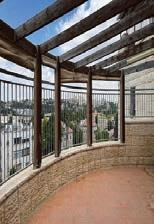


2 underground parking and 3 storage units!!!
25 sqm Sukka terrace off living room plus large roof top terrace. NEW PRICE!
5,950,000 NIS
In the heart of BAKA enclosed in a magical courtyard:
3 bedrooms 2 full bathrooms one flight up. Beautiful spacious sukka terrace facing open gardens. Completely renovated with architectual design & high level finishes.
6,250,000 NIS
2 The verb “to love,” a-h-v, is related to the verbs h-v-h, h-v-v, and y-h-v, all of which have the sense of giving, bringing, or offering.
Eta Morris Realty, Ltd.

etamorrisrealestate@gmail.com
Eta: 054-723-3863 · Rachel: 052-546-6425
etamorrisrealty.co.il
OU ISRAEL CENTER 19
biblical age, sacrifices were so important –not as they were in other faiths but precisely because at the beating heart of Judaism is love: “You shall love the Lord your God with all your heart, and with all your soul, and with all your might.” In other faiths the driving motive behind sacrifice was fear: fear of the anger and power of the gods. In Judaism it was love.
We see this in the Hebrew word for sacrifice itself: the noun korban, and the verb lehakriv, which mean “to come, or bring close.” The name of God invariably used in connection with the sacrifices is Hashem, God in His aspect of love and compassion, never Elokim, God as justice and distance. The word Elokim occurs only five times in the whole book of Leviticus, and always in the context of other nations. The word Hashem appears 209 times. And as we saw in the previous parsha, the very name of the book, Vayikra, means to summon in love. Where there is love, there is sacrifice.

Once we realise this, we begin to understand how deeply relevant the concept of sacrifice is in the twenty-first century. The major institutions of the modern world – the liberal democratic state and the free-market economy – were predicated on the model of the rational actor, that is, one who acts to maximise the benefits to their self. Hobbes’ account of the social contract was that it is in the interests of each of us to hand over some of our rights to a central power charged with ensuring the rule
of law and the defence of the realm. Adam Smith’s insight into the market economy was that if we each act to maximise our own advantage, the result is the growth of the commonwealth. Modern politics and economics were built on the foundation of the rational pursuit of self-interest.
There was nothing wrong with this. It was done for the highest of motives. It was an attempt to create peace in a Europe that had for centuries been ravaged by war. The democratic state and the market economy were serious attempts to harness the power of self-interest to combat the destructive passions that led to violence.3 The fact that politics and economics were based on self-interest did not negate the possibility that families and communities were sustained by altruism. It was a good system, not a bad one.
Now, however, after several centuries, the idea of love as sacrifice has grown thin in many areas of life. We see this specifically in relationships. Throughout the West, fewer people are getting married, those who do are getting married later, and almost half of marriages end in divorce. Throughout Europe, indigenous populations are in decline. To have a stable population, a country must have an average birth-rate of 2.1 children per female. In 2015 the average birth-rate throughout the European Union was 1.55. In Spain it was 1.27. Germany has the lowest birth-rate of any country in the world.4 That is why the
3 The classic text is A. O. Hirschman, The Passions and the Interests (Princeton University Press, 1977).
4 The Observer, August 23, 2015.
20 TORAH TIDBITS 1511 / TZAV / SHABBAT HAGADOL - PESACH - SHEMINI
population of Europe is today rendered stable only on the basis of unprecedented rates of immigration. Lose the concept of sacrifice within a society, and sooner or later marriage falters, parenthood declines, and the society slowly ages and dies.
My late predecessor, Lord Jakobovits, had a lovely way of putting this. The Talmud says that when a man divorces his first wife, “the altar sheds tears” (Gittin 90b). What is the connection between the altar and a marriage? Both, he said, are about sacrifices. Marriages fail when the partners are unwilling to make sacrifices for one another.

Jews and Judaism survived despite the many sacrifices people had to make for it. In the eleventh century Judah Halevi expressed something close to awe at the fact that Jews stayed Jewish despite the fact that “with a word lightly spoken” they could have converted to the majority faith and lived a life of relative ease.5 Equally possible though is that Judaism survived because of those sacrifices. Where people make sacrifices for their ideals, the ideals stay strong. Sacrifice is an expression of love.
Not all sacrifice is holy. Suicide bombers sacrifice their lives and those of their victims in a way I have argued is sacrilege.6 Indeed, the very existence of animal sacrifice in the Torah may have been a way of preventing people from offering human sacrifice in the form of violence and war.
These weekly teachings from Rabbi Sacks zt”l are part of his ‘Covenant & Conversation’ series on the weekly Torah teaching. With thanks to the Schimmel Family for their generous sponsorship, dedicated in loving memory of Harry (Chaim) Schimmel. Visit www.RabbiSacks.org for more.
5 Judah Halevi, The Kuzari, 4:23.
6 See Jonathan Sacks, Not in God’s Name: Confronting Religious Violence (New York: Schocken Books, 2017).

OU ISRAEL CENTER 21
But the principle of sacrifice remains. It is the gift we bring to what and whom we love.
Former Assist. Clinical Professor of Medicine, UCLA School of Medicine; Div. of Endocrinology & Metabolism Weight loss Consultation +972 53 472 2159 Author of The 18% Solution –Lose 18% of Your weight in 18 Weeks
Dr. Harry Weisman
RABBI JUDAH MISCHEL
Mashpiah, OU-NCSY Executive Director, Camp HASC Author of Baderech: Along the Path of Teshuva (Mosaica 2021)

Shabbos HaGadol: Present Tense
In a small village near the town of Kolbisov there lived a simple Jew who made his living from the kretchma, the little inn that he rented from the local poritz. Down on his luck, the Yid was unable to make his monthly payments, and the poritz, a brutal and unforgiving landlord, resorted to violence to extract the debt. Try as he may, the Yid just couldn’t come up with the money he owed. After missing the payment deadline, a bunch of goons showed up at his door on Shabbos morning just days before Pesach to ‘send a message’ to the poor fellow. As the Yid stood at a safe distance, they tore apart the humble building, smashed the modest possessions and dumped all his Shabbos food on the ground. “If you don’t
Spend a kosher summer in Hong Kong? Yes!

We rent our perfect apartment. A step from the shul and Kosher restaurants, Disneyland, Macau, Tropical islands, unique markets etc
Very clean after renovation. Option for a housekeeper contact:
dontforgetmordi@gmail.com
pay up by tonight,” they hissed, “we’ll do the same stuff to you.”
The Yid was extremely dismayed and ran to the Beis Medrash, now his only refuge in the world. Exhausted, he squeezed into a back corner as it was packed with congregants listening to the Shabbos haGadol drasha of the Rav of Kolbisov, the Oheiv Yisrael, Rebbe Avraham Yehoshua Heschel.
“There are two kinds of brachos addressing the redemption of Am Yisrael,” intoned the Rebbe. “One of them we say before the Amidah. It is in the past tense, praising the Ga’al Yisrael, ‘Hashem, Who redeemed Israel’. The other brachah is part of the Amidah itself, composed in present tense: Go’el Yisrael, ‘He Who redeems Israel’. The first bracha is a reference to the past geulah from Mitzrayim. The second brachah, however, is in the present tense, because it refers to the redemption that is going on right now, right here, in this very moment, for every single one of us…. And even if there’s a Yid who can’t pay his rent, and the poritz is breathing down his neck threatening him, and his house was torn apart and he has not a kopek to begin paying his debts — Go’el Yisrael! The Ribbono Shel Olam is redeeming him right now from all of his tzaros! Even this Yid is going out of exile, at this very moment!”
No one present could have recognized the hashgacha pratis of the Rebbe’s choice of words except our innkeeper, who was
22 TORAH TIDBITS 1511 / TZAV / SHABBAT HAGADOL - PESACH - SHEMINI
SHABBAT HAGADOL
Newest Listings in Jerusalem















OU ISRAEL CENTER 23 Apartment on Pierre Koenig Street 3 bedrooms, 2.5 Baths 2nd floor-no elevator A/C in every room Rare & quiet Great investment/starter property! Occupancy in 1.5 years Great Apartment with Incredible Views Beautiful Family Home in the Wolfson Towers 4 Bedrooms, 2.5 Bathrooms 150 sqm Large Living Room Large Kitchen + Dining Room Area Built in Closets in all of the rooms Small Storage Room Renovated Panoramic View of Knesset and Israel Museum Unique Corner Property 4.5 bedroom 2.5 bath Succah balcony A/C + Heat Parking & Storage Available: Immediately Located in San Simon 300 sqm Private 1/2 sized Olympic Pool 5 Bedrooms, 4.5 Bathrooms Private Internal Elevator Spacious Top of the Line Kitchen Beautiful Outdoor Kitchen and Grill Huge Terrace, Jacuzzi 2 Private Parking Spots, Storage Available July 1, 2023 Shofet Chaim Hacohen Street 4 rooms + 2 full bathrooms Spacious and full of light Central A/C + heat 3 exposures Shabbat elevator Parking For Rent Unique and Luxurious Duplex Penthouse
Yitzchak Kowalsky 054-766-0338 Yitzchak@yykrealestate.com www.yykrealestate.com Upper Level Cottage in the Dan Complex For Sale/Rent For Rent
History
ATERET
Tour reservations must me made in advance and confirmed by text or email register online at ateretcohanim.org/tours In Israel call Daniel 054-654-4407 dljerusalem@gmail.com In US call Shani 917-297-2075 shaniateret@gmail.com scan here to reserve your tour Please tour with us the next time you are in Israel, you will be amazed at what we are doing to keep All of Jerusalem United with Jewish Life ^ Our RESERVATIONS MUST BE MADE IN ADVANCE Shield of Jerusalem Tours pre and post Pesach only Sunday, April 2nd Tuesday, April 4th Sunday, April 16th Old City Tours Sunday, April 9th Thursday, April 13th Ateret Cohanim tours around Yom HaAtzmaut Tours to start either 10am or 2pm Sunday, April 23rd Thursday, April 27th Sunday, April 30th Tours are filling up fast! RESERVE NOW!
Take a Walk Through
TOUR THE OLD CITY WITH
COHANIM
certain that this was Hashem speaking through the Rebbe directly to him. This Divine intervention filled him with hope and joy, and he ran out of shul dancing wildly and shouting, “The Rebbe says Goel Yisrael, He Who redeems Israel right now! Goel Yisrael! Hashem is saving even me — at this very moment!”
As he was dancing his way down the street toward his home, he bumped right into the poritz, who was out for a walk with his wife. “Ugh,” he grimaced toward his wife, “this is the dirty Jew we roughed up today, he owes us a ton of money.” But as the poritz watched him dancing away, laughing and shouting Hebrew phrases, his wife frowned and clucked disapprovingly at him. “No. It looks like the poor guy is having a breakdown. He must have cracked from all your pressure and your little band of low-life thugs. Have mercy on this zhid, he is so pitiful....”
“Okay, Okay,” demurred the poritz, rolling his eyes. “Jew! Come back over here. I have something to tell you.” The Yid still couldn’t keep his explosive joy completely under wraps but he turned around and came back. The poritz thought for a second and said, “I'll tell you what we'll do. I’ll speak with my brother who owns the distillery in Kolbisov. They’ll give you some whiskey on credit. You could sell it; maybe your luck will change, and with the profit, you can pay off the debt you owe me.”
Indeed, within the few days between
Resumes
Shabbos and Erev Pesach, the Yid sold so much whiskey that he was able not only to pay the rent he owed to the poritz, but to purchase all his Yom Tov needs and even help some of his struggling neighbors as well.
On Erev Pesach, still with a dance in his step, the Yid went to Reb Avraham Yehoshua to tell him the good news. But before he could speak, the Rebbe smiled and said, “May the Go’el Yisrael, One Who is redeeming Israel right now bless you with a joyous Zeman Ge’ulaseinu, Season of Our Ge’ulah!
“All of the blessings above and below are dependent upon the Seventh Day.”
(Zohar, Yisro)
Pesach draws its sanctity from the Shabbos before Pesach, Shabbos haGadol. This day is called “the Great Shabbos” because it contains within it the holiness of Shabbos as well as the sanctity of Pesach. The blessings of Shabbos haGadol and the days preceding Yom Tov give us another chance to believe in Hashem’s salvation and to begin again. With emunah we can become filled with joy, even if our external circumstances are excruciatingly difficult. For Hashem is certainly the Go’el Yisrael, redeeming even us, in the present tense, at this very moment!
Good Shabbos and Chag Kosher v’same’ach!
Every person who was not born in Israel and lives in the Holy Land should celebrate his/her ALIYANNIVERSARY annually!
REMEMBER! WITH ALIYAH BLESSINGS! The NEAMANS
24 TORAH TIDBITS 1511 / TZAV / SHABBAT HAGADOL - PESACH - SHEMINI
,ןיילת
אתתו אליעלד ןאכרב לכ
האעיבשד אמויב
Exercise for ladies
GET FIT WHILE YOU SIT:
April
at the OU Israel Center
16Sundays 12:45-1:30pm
Sura Faecher 0504153239
CALLING ALL TOURISTS IN ISRAEL
WELCOME TO OUR INFO SESSION ON THE REICHMAN UNIVERSITY CAMPUS
Monday, April 10, 14:00
Looking forward to seeing you there! Jonathan Davis, Head of the RRIS

UNDERGRADUATE PROGRAMS
• Business Administration
• Business & Economics (double major)
• Communications
• Computer Science (BSc)
• Economics & Entrepreneurship with Data Science (double major)
• Entrepreneurship & Business (double major)
• Entrepreneurship, BA & Computer Science, BSc (double major)
• Government
• Sustainability & Government (double major)
• Psychology
• Counter-Terrorism & Homeland
• Diplomacy & Conflict Studies
• Financial Economics
• Human-Computer Interaction (HCI)
• Organizational Behavior & Development (OBD)
• Innovation & Entrepreneurship
• Big Data
• One-Year MBA
• Healthcare Innovation
• Machine Learning & Data Science
OU ISRAEL CENTER 25
GRADUATE
MSc MA GLOBAL MBA MBA
PROGRAMS
Security Studies
RSVP: +972 9 9602700 +972 54 5628121 rris.registrar@idc.ac.il RAPHAEL RECANATI INTERNATIONAL SCHOOL AT REICHMAN UNIVERSITY
SHABBAT HAGADOL
BY REBBETZIN DR. ADINA SHMIDMAN INSIGHTS


As all of prophecy draws to a close with the end of the book of Malachi, it interesting to note the final two Pesukim:
Behold, I send you prophet Elijah the prophet before the coming of the great and awesome day of Hashem.
The second instance when we “meet” Eliyahu HaNavi is on the Seder night. The Korban Pesach is a public demonstration of sacrifice when we expressly invite others to join in sharing our feelings of gratitude and praise to Hashem for our national redemption.
And he will turn back [to G-d] the hearts of the fathers with [their] sons and hearts of the sons with their fathers, lest I come and strike the land with utter destruction.
It is significant that the penultimate posuk is repeated by the one reading the haftorah and for all intents and purposes serves as the official conclusion of all nevuah. What are the meanings and messages of the Navi’s final words and why is it that they in fact conclude the Sifrei Neviim?
The final words, in actuality the second to last posuk of the sefer, speak of Hashem sending Eliyahu HaNavi on the great and awesome day. When else do we “meet” Eliyahu HaNavi? He makes his appearance at two extremely important Jewish events - the brit milah and the Seder. What do these two events have in common? The brit milah is an opportunity to demonstrate our commitment to Hashem in our most private areas of life. Even in such spaces, we make sacrifices to be spiritually connected.
Although we don’t see him, Eliyahu joins us at the brit milah and Pesach seder to acknowledge the sacrifice both private and public of the Jewish people. His presence indicates that there is a connection between our deeds and the Divine presence, that our sacrifices are valued. Despite the lack of prophecy, our connection to Hashem is appreciated and maintained.
The Navi closes with this posuk to demonstrate that before the great and awesome day of G-d,
-
HaNavi will arrive as a witness to generations of sacrifice. He will attest, as the harbinger of Mashiach, that just as the hearts of fathers and children will be reunited, the connection between our Father and His children will be restored. May we merit to see the time when we will be able to greet Eliyahu HaNavi in the rebuilt Yerushalayim, may it be speedily in our days.
Chag
Kasher V’Sameach!
26 TORAH TIDBITS 1511 / TZAV / SHABBAT HAGADOL - PESACH - SHEMINI HAFTORAH
’ה םֹוי אֹוּב י ֵנְפִל אי ִבָּנַה ה ָּיִלֵא ת ֵא ם ֶכָל ַח ֵלֹׁש יִכֹנָֽא הֵּנִה ׃אָֽרֹוּנַהְו לֹודָּגַה
אֹובָא־ןֶּפ םָתֹובֲא־לַע םי ִנָּב ב ֵלְו םי ִנָּב־לַע תֹובָא־בֵל ביִׁשֵהְו ׃םֶרֵֽח ץֶרָאָה־תֶא י ִתיֵּכִהְו
אָֽרֹוּנַהְו לֹודָּגַה ’ה םֹוי,
Eliyahu
Rebbetzin Dr. Adina Shmidman is the founding director of the Orthodox Union Women’s Initiative and the rebbetzin of the Lower Merion Synagogue in Bala Cynwyd, PA.
היונבה םילשוריב האבה הנשל
Couldn’t make to Jerusalem this Pesach? We’ve brought Jerusalem to you
View over 100 virtual tours in Jerusalem and choose your next home from the comfort of your temporary home.

www.remaxjeruslalem.com

Huge villa, divided into spacious living level + 5 additional units. 375 sqm. Double parking, garden, balcony, machsan.
NIS 6,900,000
Emuna Dadon 054-806-7106
Prestigious apartment in Mandate building

High ceilings, architecturally designed 112 sqm. 2 bedrooms (both ensuite), 3 balconies, 1st floor. NIS 7,300,000

Alyssa Friedland 054-668-4111
Authentic Arab style house, unique and charming, first floor, 4 rooms, 113 sqm, 3.8m high ceilings. Near City Center and Meah Shearim. NIS 5,490,000
Israela Krakauer 052-577-4853
Newly renovated, 4 bedrooms, 3 full baths,150 sqm, large balcony with amazing view, U/F heating, central a/c, elevator, parking. NIS 6,465,000
Ariyel Maresky 072-392-2109
Beautifully renovated, great location! 4 rooms, 91 sqm, master bedroom with ensuite bathroom, lots of natural light! NIS 3,580,000 (flexible)
Micha Paul 052-511-6340
Ze’ev

4 room duplex-penthouse, 123 sqm, with a 40 sqm balcony. Storage. Private parking, A/C. Available for immediate entry. NIS 2,926,000
Emuna Dadon 054-806-7106
Architecturally designed, beautiful penthouse apt, 5 rooms, 3 bathrooms, Succah, parking, storage. Perfect for a family- ready to move in. NIS 6,400,000
Orna Even 054-621-6069
Unique property surrounded by gardens. 8 bedrooms, large living room, indoor pool, gym, private parking.

NIS 10,600,000
Benyamin Zerbib 055-665-4123
Hanasi












New Tama 38 project across from the President’s house. 2 apts for sale:
1) 110 sqm; 2) 90 sqm garden apt Call for additional information




Orna Even 054-621-6069

OU ISRAEL CENTER 27
Be'erot St, Giv'at Ze'ev
HaAyin Het, Musrara
Sherf St, Pisgat Ze’ev
St, Talbieh
Yiftach St, Baka Penthouse
Balfour St, Talbiyeh
Pierre Koenig St, Baka/Talpiyot
Tuscan House, Irit St, Gilo
Horkania Penthouse, Katamon/Rasco
Cleaning
The entire home must be cleaned of all edible chametz. Check and clean out any place where chametz may have entered during the year. (If you have kids at home, this might mean under the beds, in the closets, and of course, in your car!) Either clean all toys or set aside designated clean toys.
Selling
There is a custom to sell chametz to a non-Jew, if (for certain reasons) it would be impractical to dispose of the chametz. Place chametz in a specially marked and sealed place, e.g. a room or closet. That storage space can then be leased to a non-Jew for the duration of the holiday. Ask your Orthodox rabbi to help you arrange this. For guidelines on what can and should be sold, see page 39.
Different Utensils
Year-round cooking and eating utensils should not be used, and separate utensils should be purchased exclusively for Pesach use. (In some cases, year-round utensils may be kashered for Pesach use, in consultation with a rabbi.) Check out our “Kashering Primer” on page 10, for more details.



What exactly is chametz?
Chametz is any food created by allowing grain (specifically wheat, oat, spelt, rye or barley) and water to ferment and rise. This is often referred to as “leaven.”

Laws and Customs for Pesach

Some common examples of chametz are bread, crackers, cookies, pretzels and pasta. Even foods with minute amounts of chametz ingredients, or foods processed on utensils or machinery that are used for chametz, are not permissible for Pesach use. Practically speaking, any processed food that is not certified as kosher for Passover may potentially include chametz ingredients and should not be eaten on Pesach.
The busy days before Pesach — special mitzvot and customs

Have you combed every inch of your home for wayward chametz, turned over your kitchen into an aluminum-foil-covered spaceship, and searched all corners?

28 TORAH TIDBITS 1511 / TZAV / SHABBAT HAGADOL - PESACH - SHEMINI
What does this look like in practice?
>>>>>>>>>>>>>>>>>>>>>>>>>>>>>>>>>>>>>>>>>>>









OU ISRAEL CENTER 29 Hod Denya Jerusalem Assisted Living For details and registration: 02-5001177 21 Golomb St., Jerusalem | Search Hod Denya on www.hoddenya.com OCCUPANCY SOON! Hod Denya, the prestigious retirement residence for the third age, is launching a first of its kind sale! Swimming Po ol The ater, Movie and Le cture Hall He alth C enter Cl as s e s and Leis ure Activitie s Fitne s s C enter and Gym Organize d Trip s Me dic al St aff An Apartment in Jerusalem In Your Name in the Land Registry pay And The Rest at Occupancy * $100 000 THE ONLY RETIREMENT COMMUNITY IN JERUSALEM WHERE YOU OWN YOUR APARTMENT!! Hod Denya Rabbi Dr. Nachum Amsel 0522-52-00-31 Namsel@netvision.net.il
You’ve made it to the Seder!
Here’s your overview of the mitzvot of the Seder:
The Seven Mitzvot of the Seder
There are two Torah obligations and five rabbinical obligations to perform during the Seder.
Torah Mitzvot:
1. Relating the story of the Exodus (Maggid—reading from the Haggadah).
2. Eating matzah.
The Seder Plate
The Seder plate is arranged with symbolic foods that follow the order of the Haggadah. The prepared plate is placed in front of the leader of the Seder, who gives out the various foods to each participant at the relevant times.
What do we put on the Seder plate?
Charoset: a mixture of apples, nuts, wine, and cinnamon, symbolizing the bricks and mortar of ancient Egypt
Karpas: a vegetable (preferably parsley, radish, potato, or celery)
Maror: bitter herbs (may consist of romaine lettuce, endives, or pure horseradish)
Beitzah: a roasted or boiled egg

Zeroa: a piece of roasted or boiled meat or poultry
Salt water: Place a bowl of salt water for dipping the karpas near the Seder plate.
Rabbinical Mitzvot:

1. Arbah Kosot: Drinking four cups of wine.
2. Maror: Eating bitter herbs.
3. Hallel: Reciting psalms of praise.
4. Afikoman: Eating an extra piece of matzah for dessert as a reminder of the Pesach offering.
5. Demonstrating acts of freedom like sitting with a pillow and leaning to the left when eating matzah and drinking wine.
Bitter herbs (maror)
Everyone is obligated to eat bitter herbs twice at each Seder:
1. A kezayit of maror, dipped in charoset
2. A second, smaller amount, inside the matzah sandwich (korech)

Maror must be raw and unpreserved. Therefore, commercially prepared grated horseradish, which is packed in vinegar, may not be used for the mitzvah.
Telling the story of the Exodus and singing Hallel
We encourage young children to participate in the Seder to the best of their ability. It is customary for the youngest person at the Seder to ask the Four Questions.
We close the Seder with Hallel, which praises G-d and His special relationship with the people of Israel. The Seder traditionally concludes with singing (and dancing to) several lively songs that celebrate our treasured relationship with G-d.
Matzah
Three whole matzot are placed next to the Seder plate. We are commanded to eat matzah three times during the Seder:
1. At the start of the Seder meal (with a special bracha)
2. For korech (Hillel sandwich) together with the maror
3. For the afikomen (at the end of the meal)
For details on the specific amounts and requirements see “Sizing Up the Seder” on page 16.

When Passover ends
All dietary laws and restrictions remain in effect until nightfall of the eighth day of Pesach. Chametz that was properly sold may only be eaten once the resale is confirmed by your rabbi (agent). Chametz that was in the possession of a Jew during Pesach is forbidden for consumption by any Jew, even after Pesach.
30 TORAH TIDBITS 1511 / TZAV / SHABBAT HAGADOL - PESACH - SHEMINI
see the OU Israel Kashrut Magazine for more Pesach laws and guidence https://issuu.com/orthodoxunion/docs/low_res_israel_passover_guide_2023 7 14 www.oupassover.org
Please
Dorona Reingold
M.Ed- Educational Consultant
Helping parents navigate the Israeli school system, and meeting the needs of students with learning disabilities, ADHD or other learning challenges.


Guiding you through the process of acquiring the best possible school experience for your child.

Meetings in person or on Zoom.
doronareingold.com
This week: KIMCHA DEPISCHA!

• Checks: Make out to “Yesh Ezra”
054-948-1062
Send to: Yesh Ezra, POB 31476, Romema, Jerusalem, 9136101




• Bank Transfer: Bank Mercantile (17), Branch 642, A/C 79747843, Yesh Ezra

To obtain your tax benefit receipt, send details by Whatsapp/email.
• Credit card: Sara at 077-820-0196
(Sun-Thu. 10:00am-3:00pm)
• Website: www.yeshezra.org
Click on “Donate Now”
Inquiries:
Menachem Persoff
050-570-1067

menpmp@gmail.com

+972 54.441.5704 KimBashRealEstate.com Wishing Everyone a Chag Kasher V'Sameach! ISRAEL'S REAL ESTATE ISRAEL'S REAL ESTATE REAL ESTATE MATCHMAKER MATCHMAKER MATCHMAKER GET A BEACH HOME WITH A SEA VIEW Ir Yamim, Netanya. New Tower, 4 Bedrooms, 5 Mins Walk to the Beach. Prices Start at 5MNIS BUY A HOME IN RBS ALEPH Attached Cottage, 6 Bedrooms, 2.5 Baths, 170 sqm, 360 sqm Exterior, Wrap Around Garden, Fruit Trees, 2 Parking Spots & Storage. 4.25MNIS LARGE AUTHENTIC OLD CITY HOME High Ceilings, Beautifully Decorated, Includes 2 Separate Rental Units, 2 Mins From The Kotel. 16.5MNIS
Pesach Candle Lighting Times
32 TORAH TIDBITS 1511 / TZAV / SHABBAT HAGADOL - PESACH - SHEMINI
SHEL PESACH SHABBAT CHOL HAMOED LEIL HASEDER Havdalah Candles Havdalah Early Candles Havdalah Candles Yerushalayim / Maale Adumim 7:43 6:30 7:40 5:43 6:27 7:39 6:25 7:44 6:47 7:43 5:45 6:44 7:40 6:43 Aza area (Netivot, S’derot, Et al) 7:44 6:48 7:41 5:44 6:45 7:39 6:44 Beit Shemesh / RBS 7:43 6:45 7:41 5:43 6:42 7:39 6:41 Gush Etzion 7:45 6:46 7:42 5:43 6:44 7:40 6:42 Raanana/ Tel Mond/ Herzliya/ K. Saba 7:45 6:46 7:41 5:44 6:43 7:40 6:41 Modi’in / Chashmona’im 7:45 6:47 7:43 5:45 6:44 7:41 6:42 Netanya 7:44 6:46 7:42 5:45 6:43 7:40 6:42 Be’er Sheva 7:45 6:46 7:42 5:45 6:44 7:40 6:42 Rehovot 7:45 6:30 7:42 5:45 6:27 7:40 6:25 Petach Tikva 7:44 6:45 7:41 5:44 6:43 7:39 6:41 Ginot Shomron 7:45 6:37 7:43 5:45 6:34 7:41 6:32 Haifa / Zichron 7:43 6:45 7:40 5:43 6:42 7:39 6:40 Gush Shiloh 7:45 6:47 7:43 5:45 6:44 7:41 6:43 Tel Aviv / Giv’at Shmuel 7:43 6:49 7:41 5:43 6:46 7:39 6:45 Giv’at Ze’ev 7:43 6:45 7:41 5:44 6:42 7:39 6:41 Chevron / Kiryat Arba 7:45 6:47 7:43 5:46 6:44 7:41 6:43 Ashkelon 7:45 6:46 7:42 5:45 6:44 7:40 6:42 Yad Binyamin 7:43 6:40 7:41 5:43 6:37 7:39 6:35 Tzfat / Bik’at HaYarden 7:43 6:44 7:40 5:42 6:41 7:38 6:40 Golan Rabbeinu Tam (J'lem) Leil Haseder 8:18PM • Shabbat Chol Hamoed 8:20pm • Shvii Shel Pesach 8:21pm
SHVII
AND A FREE SHABBAT MECHANISM
Immediate delivery before the Chag
Get to shul easily on Shabbat? Load the scooter into the car’s trunk and drive to the children for Shabbat? Fly to a fun vacation abroad? With a SHABBATTO mobility scooter, anything is possible! It features an integral “mehudar” mechanism, and therefore doesn’t require tricky and costly installation, as in other scooters.




For more information and a free, no-obligation demo: movinglife.co.il/torah
077-2305650
OU ISRAEL CENTER 33
THE FREEDOM OF MOBILITY EVEN ON SHABBAT AND CHAGIM
Splits into 2 lightweight parts, for easy lifting. is approved for air travel.
Spacious legroom and high ground clearance.
SPECIAL PESACH OFFER
NIS OFF 1000
KI TEITZEII
PESACH TORAH READING
ALIYA-BY-ALIYA SEDRA SUMMARY
Rabbi Reuven Tradburks Director of

RCA Israel Region
1ST DAY OF PESACH
1st aliya (Exodus 12:21-24) Offer the Pesach offering, place its blood on the doorposts and remain indoors ‘til the morning. For G-d will pass over the homes identified with the blood and your firstborn will be spared. This law is eternal.
The simplicity of this narrative belies its drama. Take the Pesach, offer it; and they did. The willingness of the people to be defiant of Egypt, to slaughter its god (the lamb) is striking. The slave people listened to their G-d regardless of the risk from their overseers.
And this is the first act of loyalty demanded of the Jewish people by G-d. All of the Torah has been G-d’s promises to us. Now he asks for our hand to be stretched to Him in return. The Holy One could have redeemed us, could have passed over our homes without the blood on the doorposts. But He wanted us to stretch our hand to Him.
2nd aliya (12:25-28) When you enter the Land and your children ask you what this service
is, you will answer that this is a Pesach, as Hashem passed over our homes. The people did as Moshe commanded.
These simple verses are as dramatic as the first. “When you enter the Land”? What? Slaves are being told to keep this mitzvah when they enter the Land? The Land of Israel is the farthest thing from their minds, mired in slavery. From the dawn of our history we have fantastic dreams and visions of the future, ignoring the grimness of the reality of the moment.
3rd aliya (12:29-36) At midnight all the firstborn in Egypt are killed. Paro orders Moshe and Aharon to leave and take all the people to their festival and to bless him as well. The Egyptians urged the Jews to leave quickly. The Jewish people took unrisen dough and gold, silver and clothing from the Egyptians.
While the buildup to this moment took many months, the redemption occurs in a flash. Out. Now.
Even the Jews, knowing they are going to be redeemed that night, are unprepared for the moment. Even when we know the moment is coming, that anticipation tempers not the astonishment of the moment. They had not prepared provisions. Faithful they were; prepared, not.
4th aliya (12:37-42) The people left, including 600,000 of military age, many others who joined, and laden with flocks. The dough was baked hastily as they were expelled in haste. The Jews lived in Egypt 430 years; they departed after exactly 430 years. This day that G-d anticipated for their departure remains a noted day for Jews forever.
The Torah emphasizes that this was the
34 TORAH TIDBITS 1511 / TZAV / SHABBAT HAGADOL - PESACH - SHEMINI
day destined from the start for the redemption. From our perspective the redemption was sudden; we were unprepared. But from His perspective, this was in the cards the whole time. He anticipated it before it happened; we mark that day after it happened.
5th aliya (12:43-51) The Pesach Offering: non-Jews may not participate, must be eaten in one home, may not be taken out of the home, no bone may be broken, all Jews participate. One who joins the Jewish people and is circumcised may join the Pesach; there is one law for all. On that day G-d took the Jewish people out of Egypt.
The law that the Pesach may not be taken out of the home sounds an awful lot like the laws that korbanot cannot be taken out of the Mikdash. Our homes become the Mikdash on the Seder night.
Circumcision and the Pesach are 2 sides of the same coin – Brit Milah is a sign of the covenant with G-d, while Pesach is our yearly renewal of dedication to that covenant.
SHABBAT CHOL HAMOED
The Torah Reading for Shabbat Chol Hamoed is taken from Parshat Ki Tisa (Shemot 33:12). The second Torah is read from Bamidbar (28:19). The Haftorah is Yechezkel 37

7TH DAY OF PESACH


1st aliya (Exodus 13:17-22)

The people traveled away from Egypt toward the sea. Moshe took the bones of Yosef, as Yosef had instructed them to do. A Divine cloud guided
Happy Passover
from the leading agency in Jerusalem and the surrounding area!
FOR SALE COZY & AIRY APT, MACHANE YEHUDA, JLM 2BR |4th floor |45m² built |4m² balcony NIS 1,910,000 - Mendel: 052-720-3497
FOR SALE AIRY AND BRIGHT APT, MEKOR HAIM, JLM 3BR|3rd floor|100m²|2 balconies|in new condition NIS 3,880,000 - Ouriel: 058-516-1356
FOR SALE SPECTACULAR PENTHOUSE, OLD KATAMON, JLM 4.5 BR penthouse |140m²| roof terrace with view NIS 7,490,000 - Noa: 052-870-2387
FOR SALE
FOR SALE
FOR SALE
FOR SALE
FOR SALE
ATTRACTIVE PROPERTY, NACHLAOT, JLM 2 BR | 65m²|balcony|parking|storage NIS 2,730,000 - Tehila: 050-420-5333
Exptected occupancy: Dec. 31st '23
APT WITH GORGEOUS VIEW, HAR HOMA, JLM 3BR|81m²|2 bathrooms |Ground floor out of 5 NIS 3,100,000 - Ouriel: 058-516-1356
AMAZING TUSCAN STYLE HOUSE, MOSHAV LUZIT 5 BR|735m² lot| built 265m²|60m² pool|4.5 baths NIS 6,350,000 - Noa: 052-870-2387
COTTAGE WITH TREMENDOUS POTENTIAL, EFRAT 5BR |176m²|3 baths| garden |sukkah balcony
NIS 3,500,000 - Noa: 052-870-2387
COTTAGE WITH TREMENDOUS POTENTIAL, EFRAT 6BR|190m²|on 4 levels|3 baths|sukkah balcony
NIS 3,690,000 - Noa: 052-870-2387



FOR SALE BEAUTIFUL SEMI-DETACHED HOME, EFRAT 5BR |3 stories |180m² built |160m² garden
FOR SALE
NIS 4,950,000 - Noa: 052-870-2387
FABULOUS APT WITH CHARMING YARD, MITZPE YERICHO 6BR | 165m² built | 70m² garden|storage unit NIS 3,390,000 - Mordechai: 052-720-3089
FOR SALE PRIVATE HOME WITH STUNNING VIEW, MITZPE YERICHO 5BR|4 baths|330m² built|500m² lot|sukkah balcony
NIS 4,300,000 - Mordechai: 052-720-3089



WHILE YOU'RE HERE FOR PESSACH, get in touch with our real estate experts to ask questions about the real estate market in Israel.
Noam: 052-848-7391 Noa: 052-870-2387
OU ISRAEL CENTER 35
BS″D Real Estate | Investments | Management services Noam Homes THIS IS THE TIME TO MARKET YOUR PROPERTIES IN A REAL ESTATE OFFICE WITH EXCELLENT EXPOSURE! Scan to visit our site www.noamhomes.com BS″D Scan to visit our site www.noamhomes.com Real Estate | Investments | Management services www.noamhomes.com | office@noamhomes.com Noam Even 058-793-2222 2020 From your friends at NOAM HOMES Real Estate Professionals The TOP 10 Real Estate Office in Jerusalem for 2020 & 2021 (MADLAN) HAPPY Passover NACHLAOT Great Investment Property, devided into 3 units! Beautiful room duplex, built to a high standard! Lot with with Complex private Authentic 5.5 room Home with character and beauty! MALCHA NACHALAT ACHIM GERMAN Look for us: NOAM HOMES Noam Homes 24 Even Sapir St., Jerusalem 058-793-2222 office@noamhomes.com
SALE
JLM
levels|180m²
Tehila:
SALE
room
FOR
AMAZING GARDEN APT, BET HAKEREM,
4BR|179m²|on 3
garden|renovated NIS 8,400,000 -
050-420-5333 FOR
QUIET STUDIO APARTMENT, NACHLAOT, JLM 1
| Ground floor | 20m² | renovated NIS 1,380,000 - Tehila: 050-420-5333
them by day, fire by night.
Yosef was so confident in the redemption from Egypt, he was willing to have his bones remain in Egypt, to be brought out of Egypt when the Jewish people were redeemed. For Yosef, the Divine promise was not mythical; it was a certainty.
2nd aliya (14:1-14:8) The people camp at the sea; Paro pursues with the elite of his fighting forces.
3rd aliya (14:9-14) With the sea in front of them and Paro in pursuit, the people are desperate. They question why Moshe brought them out of Egypt to die in the desert. And state: this is what we said in Egypt. We would rather remain in Egypt to live and work as slaves than leave Egypt to die in the desert. Moshe reassured them.
This is the first we hear of the reluctance of the people to leave Egypt. While the Torah tells the story of the Jewish people leaving slavery, that doesn’t mean that every Jewish person was a willing participant. Skepticism is not a modern invention; it is part of the human condition. But, while skeptical, they took their place as part of the Jewish people who were redeemed. Skeptics join the Jewish adventure of redemption, albeit skeptically.
4th aliya (14:15-25) G-d tells Moshe to march forward, raise his staff over the water, the water will split and the people will proceed
through the water. Moshe does so, the sea splits, the people march through and the Egyptians pursue. By daybreak the Egyptians are stuck in the sea, claiming G-d is fighting the battle of the Jews.
Redemption occurs with water. The first thing in creation was water; verse 2 in the Torah states G-d’s spirit hovered over the waters. Water recurs as a symbol of beginnings. The splitting of the sea and the redemption from Egypt closes a chapter of Jewish history and opens a new beginning. It is the beginning of the national march to receive the Torah and to enter the Land of Israel. A new beginning marked by water.
5th aliya (14:26-15:26) The sea waters return, drowning the Egyptians. The people sing Az Yashir, the song of thanks. Miriam leads the women in song. The journey into the desert begins.
Redemption brings song. This song creates a religious paradigm. When we are the recipients of Divine gifts, we must respond with appreciation and joy. This is reflected in our siddur as well. When we mention the exodus from Egypt in the brachot of the Shema we include that the people sang this shira. What He does must be responded to by what we do. Song.
URGENT TZEDAKAH APPEAL

for very ill, lonely widow woman with no family. Cancer survivor/ serious heart condition. Desperately needs money for basic needs/ medical expenses/place to live.
joanmarastern@gmail.com Phone 058-778-0691

Endorsed by: Rabbi Zev Leff/Rabbi Yaacov Hillel/ Rabbi Simcha Sheinberg/ Rebbetzin Dena Weinberg/Rabbi Yisrael Gans/Rabbi Dayan Dunner Donations can be sent to:
Rebbetzin Tzipporah Gottlieb-Heller, Neve Yerushalayim Seminary, 1 Beit Yitshak Street, Har Nof, Jerusalem 94130 or to Matat Mordechai Charity, Tax deductible Bank Mizrachi Tefachot. Bank 20. Branch 520, account 128764. Widows account 3649
36 TORAH TIDBITS 1511 / TZAV / SHABBAT HAGADOL - PESACH - SHEMINI
TRANSFER YOUR OLD FILM/VIDEO's (All formats) In Quality to Digital Preserve Family History from Fading Michael 052.286.8626
Facebook.com/L'Dorot Photography
Photography with feeling


OU ISRAEL CENTER 37

38 TORAH TIDBITS 1511 / TZAV / SHABBAT HAGADOL - PESACH - SHEMINI As we open our Seder with these words; let’s remember that it’s not only about food and hunger. It’s a call to open our doors and hearts to everyone in our community. Wishing you and your loved ones a happy, meaningful and inclusive Pesach. Yachad a division of Yachad is dedicated to enriching the lives of Jewish individuals with disabilities and their families, by enhancing their communal participation and their connection to Judaism through social and educational programs and support services. LetALLwhoare hungrycomeandeat 02-656-8048 YachadIsrael@ou.org Yachad_Universe

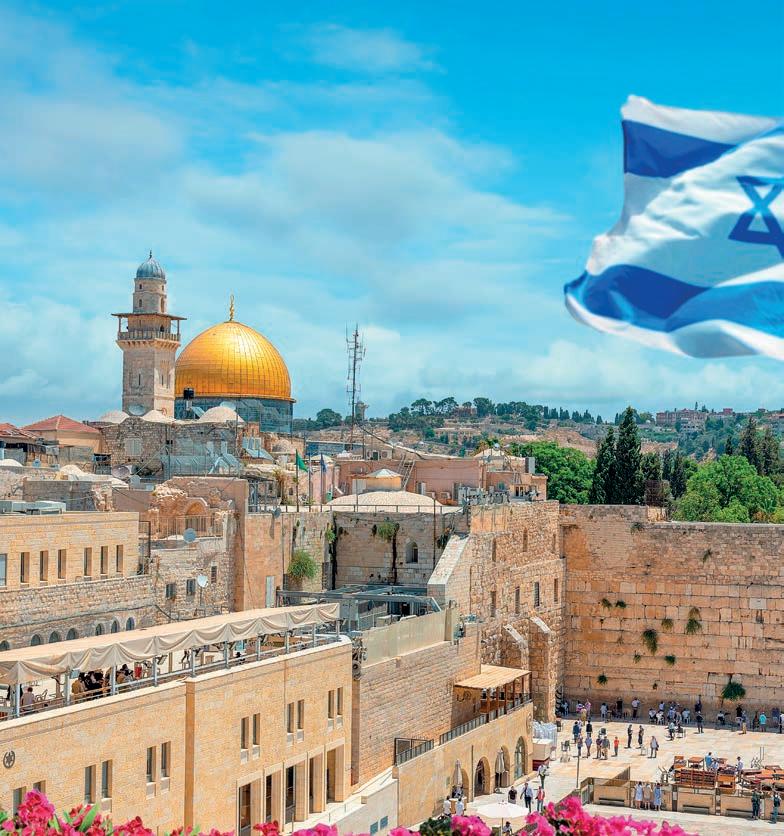

OU ISRAEL CENTER 39 Happy Passover From Mizrahi-Tefahot
Bank offers a team of banking experts who understand your culture and language. We provide you with personal and professional services for all your financial needs.
and join us. For further information, contact: Jonathan Gross +972-52-569-0674 | grossj@umtb.co.il
Mizrahi-Tefahot
Come
PROBING THE PROPHETS
BY RABBI NACHMAN (NEIL) WINKLER Faculty, OU Israel Center
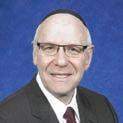
“HaTichyena Ha’atzamot Ha’ela?”
“Can these dry bones come to life?”
The haftarah established by our ancients to be read on Chol HaMoed Pesach does not mention Pesach at all. At first glance, it would seem to be a curious choice. After all, the selection from Sefer Yehoshua that is read on the first day of the chag, tells of the very first Korban Pesach that was offered in Eretz Yisrael, and, is, therefore a fitting selection for the first day. Likewise, David’s song of praise from Sefer Shmuel B which is read on the seventh day, is also an understandable choice as it echoes Israel’s song of praise at Kriyat Yam Suf, that was sung on the seventh day. But why do we read Yechezkel’s vision of dry bones on Shabbat Chol Hamo’ed Pesach? A logical question. With a logical answer.
“Z’man Cheiruteinu”, our “Festival of Freedom” was never meant to be a simple “reminiscence” of the exodus from Egypt alone. It was not to be limited to our past redemption. “Z’man Cheiruteinu” is better
understood as the “Season of Freedom” and as such, our dream for a future redemption is part of the theme and the observances of Pesach. It is with this understanding that we turn to the haftarah for Shabbat Chol HaMo’ed Pesach.
The well-known prophecy of the vision of the Valley of Dry Bones found in the 37th perek of Sefer Yechezkel, captured the imagination of the early Zionists who saw the prophetic words as a message of renewal and rebirth, reflecting their view of the return of the Jewish nation to its homeland, where they labored to reawaken its lifeless agriculture and revive its ancient practices.
They believed that, indeed, the dry bones would yet come back to life!
In fact, I was told that, in the first decades after her independence, Israel had the students in their public schools memorize this vision of Yechezkel! And why not? It was the dream of the future redemption, a dream they hoped to realize through their efforts. And, seeing the once-arid land give forth her fruit and the once-barren country repopulated with her children, why should they not recognize Yechezkel’s vision as coming true?
HaRav Amnon Bazak points out that Hashem’s revivication- revitalization – of the dry bones follows a specific progression. First, the bones will be brought together and connect to one another.

40 TORAH TIDBITS 1511 / TZAV / SHABBAT HAGADOL - PESACH - SHEMINI
PESACH
Rabbi Winkler's popular Jewish History lectures can be viewed by visiting the OU Israel Video archive: https://www.ouisrael.org/video-library
Second, sinew and flesh would come up. Third, skin would be drawn over them and, finally, “ru’ach” breath and spirit would be blown into them and bring them to life. There would be separate phases to bringing life to the bones. The first three phases would focus on the physical structure of the dry bones and only after that, would Hashem grant them life by providing them with “breath”, i.e., spirit.
REBBETZIN SHIRA
Most exquisite properties in Jerusalem!!


SMILES Faculty, OU Israel Center
Tribute to the Trio
Rav Bazak contends that those who grieved over the churban, and suffered in the “golus” had little hope of ever seeing the rebirth of a devastated community. Hashem expresses their feelings in our haftarah: “… hinei omrim…`avdah tikvateinu` ” –“they [the exiled] proclaim `our hope is lost` ”. Clearly the purpose of the vision to Yechezkel was to encourage this lost community that there would yet be a rebirth, that there would be another redemption; and that the dry bones would come back to life.
In a deeply powerful scene, Moshe Rabbeinu is found with his hands held high on top of the mountain praying for the people gripped in a raging battle with Amalek below. Ahron and Chur stood on either side of Moshe Rabbeinu holding his hands aloft (Shemot 17;10). Rashi teaches that Chur was the son of Moshe’s sister, Miriam. What more do we know about Chur?
NEW Listing! Quiet Old Katamon, new 3 rooms, Gem, totally renovated, top standard, amazing views to the forest, succah balcony, parking, storageMAYA-054-6650184
NEW Listing! Rechavia, beautiful building, spacious 3 rooms, 100m, succah terrace, private parking, storage roomMAYA-054-6650184
New luxurious penthouse in the best Rechavia285m on one level, high end building, beautiful views from succah terraces of 190m, 4 parking spots, storages, 4 exposures, very sunny!!
DEBORAH-054-4804767
NEW Listing! FOR RENT!! Luxurious 300m penthouse with private pool on a 200m terrace, panoramic views of Jerusalem MAYA-054-6650184
And this is also part of the message of Pesach. It is not enough to celebrate the PAST redemption from Egypt; one must also celebrate – and affirm - their belief in the FUTURE redemption from the Diaspora. And it is essential for our generation, to use our Pesach as a time to recognize the current – miraculous – redemption that we experience daily.
What is the symbolism of his joining with Ahron to support the hands of Moshe Rabbeinu?
Rabbi Roberts in Through the Prism of Torah explains that Ahron and Chur personified contrasting character traits. Ahron was a peacemaker, he constantly looked for ways to create harmony among his people. Indeed, he was ready to compromise his own values to achieve this goal, as we see in the story of the sin of the golden calf. Chur,
In must be a festival when we open our ears to the million voices who can declare today what past generation could not: “OD LO AVDA TIKVATEINU!!”
Luxurious apartment in Talbieh- doorman, pool, gym, 177m on one level, 32m terrace, beautiful views to the park, parking, storage DEBORAH- 054-4804767
Luxurious garden apartment on a small lane of Old Katamon, 340m built on 2 levels, 8 rooms, separate unit with separate entrance, high ceilings, full of charm, very quiet & bright, 130m private garden, top of the line finishes, close to the park
DEBORAH- 054-4804767

In a small lane of the German ColonyUnique Authentic house of 700m built on a huge plot of 1,200m - perfect for making an apartment building or a tremendous private housePotential to build up to 2,000m DEBORAH - 054-4804767
Magnificent Authentic private house on a small dead end of Baka650m built on 3 levels with huge basement, 750m plot with a wonderful landscaped garden. With a thoughtful layout, an abundance of light and great bones, it is a unique property! Call DEBORAH- 054-4804767
on the other hand, was a person who stood strong in his values, unbending and resolute in his beliefs. Chazal teach that Chur tried to challenge the people when they wanted to build the calf and they subsequently killed him. Chur, a descendent of Yehudah, was a person who was inflexible and strong like a lion. Truly, a combination of both qualities is necessary. In interpersonal relationships it is wise to follow Ahron’s path, to compromise and make peace whenever possible. However, in the service of Hashem and reinforcing kevod shamayim, one needs to follow Chur’s example and be resolute in his values. These two special people joined Moshe Rabbeinu to activate the merits of these approaches as he implored Hashem to have mercy on His people and vanquish Amalek, physically and spiritually.
On the exquisite Dubnov St. in Talbieh, private 135m cottage, totally renovated with 65m private landscaped garden, views from balconies, a real gem! Call MAYA- 054-6650184
For Sale - Gorgeous apartment in Old
In a small lane of the German Colony, Garden apartment with private entrance, 250m with private garden, parking, high ceilings, in an Authentic beautiful 3 apartments building MAYA – 054-6650184
Katamon
In a unique Old Arab style building - Spacious 110sqm, 4 room apartment with Sukah balcony, Shabbat elevator, parking & large separate storage room. lots of character, excellent condition, central A/C Truly one of a kind! 5,280,000nis
For Sale – Old Katamon, Negba st., 1st floor, Arab house, 4 rooms, (total about 160m), high standard of renovation, Sukkah porch, 2 full bathrooms + guest bathroom, central a/c, elevator, parking, small machsan, asking $2,550,000
OU ISRAEL CENTER 41
T&T INVESTMENTS
King David St. 26 www.real-estate-jerusalem.co.il LEADING BOUTIQUE REAL ESTATE FIRM, O n M e n d e l e S t . T a l b i completely renovated, •
02-6744000 0544-804767
26 TORAH TIDBITS / BESHALACH 5781
RABBI SHALOM ROSNER
Rav Kehilla, Nofei HaShemesh Maggid Shiur, Daf Yomi, OU.org Senior Ra"M, Kerem B'Yavneh

Hallel- Spontaneous Praise For Clear and Hidden Miracles
A Break in the Action?
The Hallel that is recited at the Seder is a bit strange. First, we interrupt the recitation of Hallel and break for a meal. Second, we do not recite a beracha over Hallel. In addition, many congregations have the custom of reciting Hallel during the Maariv service, with a blessing. There is no other night where Hallel is recited at all, let alone twice!
Perhaps we can explain this phenomenon based on a suggestion by Rav Hai Gaon, quoted in the Ran at the end of Masechet Pesachim. He explains that this Hallel is classified as song, as shira, rather than as a reading, a kriya. What does Rav Hai Gaon mean by this?
Rav Yosef Dov Soloveitchik explains that on Pesach we experience an overwhelming sense of gratitude for having been saved
from slavery. At the Seder, after spending two hours discussing the exile and Exodus, we should truly feel an outburst of emotion, the desire for spontaneous praise.
Thus, if we were to recite a beracha, it would diminish the authenticity of our passion. We are praising God at this time because we want to, not because we are commanded. That is why we can interrupt our outpouring of praise, eat a meal and resume with our praise. That is also why we do not recite a blessing over this praise. To do so would dilute its personal authenticity. We are to feel as if we were personally redeemed and engage in spontaneous praise and express our sincere gratitude for all the good God bestows upon us.
Hallelu Et Hashem Kol Goyim
When we recite Hallel we praise God
To all of our devoted friends and donors who contributed MAOS CHITIM and helped over 200 poor and needy families enjoy the Holiday of Pesach - Best wishes for a Chag Kasher V’sameach, and a healthy spring and summer.
Send your contributions to the Clara Hammer Chicken Fund

P.O.B.18602 Jerusalem 91185
(02)5810256
Donate via PayPal at Chickenladyofjerusalem.com
חמש
42 TORAH TIDBITS 1511 / TZAV / SHABBAT HAGADOL - PESACH - SHEMINI
PESACH
גח
ץיקו
!אירב
not just for all the miracles we witness, but for those of which we may be unaware. A priest once asked Rav Chaim of Volozhin a question regarding a pasuk in Tehillim that we recite in Hallel. It says in Tehillim (117), Hallelu et Hashem kol goyim, shabehuhu kol ha’umim, all the nations of the world will praise God. Why? Ki gavar aleinu chasdo, because God showered us Jews with compassion. The priest did not comprehend why gentiles would praise God for showing compassion to the Jews.



Rav Chaim Volozhin explained to the priest that we are not cognizant of all the evil schemes that you plotted against us. Only you know exactly what you have planned for us, and Hashem acts to protect us. That is to say, you may plan to blow up a bridge and destroy a caravan of Jews, but Hashem causes your explosive device to jam, and the Jewish caravan is saved. Only you are aware of this compassionate act of the Almighty, and therefore, only you can praise God for His chesed towards Am Yisrael.
Even in those generations where there appears to be tranquility, the other nations either plot unsuccessfully against us or seek to annihilate us not through physical means, but by doing all they can to degrade us spiritually.
When we recite Hallel this Pesach, may we express our gratitude to Hashem for all He does for us. For acts of which we are aware and for his protection behind the scenes.
A small Sefer Torah with its own Aron Kodesh is available to shiva houses or for any other necessary occasion on a temporary free-loan basis.


If needed call Uri Hirsch 0545513173


FOR SALE
MEKOR CHAIM - Close to the mesila park, large 4 rooms, 98m, Shabbat elevator, 2 balconies, good shape, master bedroom, quiet. 3,700,000 NIS
GERMAN COLONY - Nice 4 rooms, modern building with Shabbat elevator, master bedroom, bright, quiet, parking, storageroom 4,600,000 NIS
TALBIEH - Large 3 rooms, in a luxury building with Shabbat elevator, sukkah balcony, master bedroom, bright, quiet, storageroom, parking, rare!

HEART OF BAKA WITH GARDENluxury 5 rooms, 200m, with private garden of 125m, large living room, 2 parking spots, storageroom, quiet, rare!
28, Kovshei Katamon Street, Jerusalem
Tel: 02.5633008 - www.ben-zimra.com
OU ISRAEL CENTER 43 Hillel -052-5955-492 M Men achem -052-5955-073 Real Estate Brokerage Property Management (Maintenance & LT rental) Project Management (Renovations & Construction) ALL YOUR UNDER ONE ROOF! ErusalEm HomEs The Mendlowitz Family business with over 40 yearsof experience in the US and Israel!
Protea in Elkana is a Senior Living for the religious community. Open a wonderful new chapter in your life and enjoy a high quality of life. With a warm, active community, social environment, rich cultural content, personal safety with 24/7 medical and security services, and an exceptionally fine living style.






44 TORAH TIDBITS 1511 / TZAV / SHABBAT HAGADOL - PESACH - SHEMINI םיבוטה םייחב םינימאמ
an
are invited to visit our project and explore a model apartment: *9405 www.proteahomes.co.il Pictures are illustration only Over 70% of our 3 bedroom apartments have Been signed, hurry and choose yours! Already under construction. Launching 2024
dozens of residents from all over Israel who have chosen an apartment in Protea Elkana
For
appointment call You
Join
Join our community for your next chapter

OU ISRAEL CENTER 45 Dr. Gedaliah Mordechai Stern STATE-OF-THE-ART
Implants Diplomate of Oral Implantology Teeth In An Hour Faster, Easier and Better than ever before. Bone grafts or sinus lifts Cutting and stitching Months without teethNot enough bone (These can usually be avoided today) Come and get a second opinion, if you were told you need: Almost always with less pain and less swelling, thanks to Lasers and Advanced Technologies. No-cost consult.No-cost x-rays (2D/3D) if have already, within last 6 months. implantsandlasers-r-us.com Ussishkin 57, Rechavia, Jerusalem 02-6258258
Dental
SMILES Faculty, OU Israel Center
Emunah Experience
Anytime we take a trip, whether it is across town or to another city, our destination is clear in our minds. We may type it into Waze or a GPS to chart our course, yet, one thing is sure, we have a clear intention and objective. Seder night is no different. It is a special journey with many important stops along the way. It is crucial to the experience that we outline our goals and aspirations for this exalted evening.
The Slonimer Rebbe in Netivot Shalom teaches that our main mission at leil haseder is to reach greater levels in emunah. He goes so far as to say that Pesach is the Rosh Hashana for emunah. It is the time of year to establish our firm commitment to believe in the Oneness, Omnipotence
Please note advertising deadlines thru Yom Haatzmaut:
Shabbat April 21-22 (Tazria-Metzora)
deadline for ads: Sunday, April 16
Shabbat April 28-29
(Acharei-K’doshim),
deadline for ads: Thursday, April 20
please email or call Ita Rochel ttads@ouisrael.org/ 02-5609125
and Sovereignty of Hakadosh Baruch Hu. Paraoh, who denied Hashem’s existence, was stricken with ten plagues to teach the Egyptians this very lesson. In contrast, Am Yisrael believed and were redeemed in the merit of their emunah. Indeed, it will be in the merit of emunah that we will be redeemed in the future. “Vechol hamarbeh le’saper… harei zeh meshubach - those who speak extensively about yezti’at mitzrayim will be praised.” Those who engender ideas of emunah, those who endeavor to infuse their family with strong feelings of emunah, are praiseworthy. Dovid Hamelech declares, “He’emanti ki adaber” (Tehillim 116;10). We can understand these powerful words to mean, “I believed because I spoke!” The more we express our emunah, the more it becomes a part of us.
Along these lines, the Netivot Shalom explains the opening line of the Haggadah inviting all who are poor and hungry to join our Seder.“Ha lachma anya … kol dichfin yetei ve’yeichol.” Our doors are closed, who exactly are we inviting into our seder?!
Rather, we look at the matzah, the “nahama de’miheimenuta – the bread of emunah,” and invite those sitting around the table to come and connect to the spiritual experience, to open themselves to grow and deepen their service of Hashem. We are all hungry; we all crave a stronger spiritual connection, a more meaningful relationship with Hashem. Tonight is the night of
46 TORAH TIDBITS 1511 / TZAV / SHABBAT HAGADOL - PESACH - SHEMINI REBBETZIN SHIRA
PESACH
potential transformation.

We must read the Haggadah through this lens of emunah. At every juncture we can pause and consider the lessons woven into each section of our story. The insights of the Klei Yakar on the words, “detzach adash be’achav” are particularly penetrating. He notes that the Torah specifies the purpose of each group of plagues before it begins. Thus, the objective of the first three plagues was to teach the Egyptians of Hashem’s existence, the second group teaches that Hashem watches over us, and the third group of plagues teaches that Hashem is all Powerful. We can discuss these ideas extensively, applying the messages to our personal lives.
Clearly, the traditional songs at the end of the Seder ensure that we integrate the essence and significance of this night. From the refrain, “Hashem is One in the heavens and the earth,” to the grand finale of the Seder “Chad Gadya,” we repeat these ideas again and again with rhyme and rhythm.

Finally, HaRav Avraham Mordechai of Gur explains, we must bear in mind that there is a ‘Seder’ to this world, there is a balance and harmony that only Hashem controls. To us, life may look chaotic and so many things seem inexplicable. Yet, at the conclusion of our journey, we must come away feeling emunah deep inside and Hashem’s over-arching guardianship as He leads us to the ultimate redemption.

OU ISRAEL CENTER 47
OU KASHRUT
BY RABBI EZRA FRIEDMAN Director, The Gustave & Carol Jacobs Center for Kashrut Education
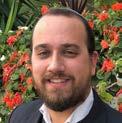
Citric Acid for Pesach
Pesach products require extra attention to detail. The prohibition of consuming chametz is so severe that even a small amount in the product might render it not kosher for Pesach. Many types of foods contain chemicals that may come from, or contain chametz. OU kosher works very hard ensure that all food additives are confirmed for Pesach approval. One of the most common chemicals used in food production is citric acid.
Citric acid is a basic ingredient in many food products, such as beverages, spices, spreads, sweets and more. Citric acid can be found naturally in citrus fruits, but in the food industry generally it is produced by combining glucose (as well as dextrose or sucrose) and a culture of aspergillus, a very common mold that exists even in homes. Citric acid is also commonly used as a preservative in many types of foods.
Citric acid is prevalent in industry as a relatively cheap edible acid. In terms of kashrut, for year-round use, the starch used as its base does not normally require special certification as it is based on any type of cheap starch available. The most common starch used to make citric acid is corn starch. However, wheat starch is also
used in is Europe and Australia.
Pesach certification
In a case where the citric acid is made from chametz, it cannot be used in any kosher for Pesach product with OU certification. Where the citric acid is of chametz origin, it would not be nullified. Even though chametz may be nullified before Pesach, since citric acid is a preservative it might be considered a ma’amid. A ma’amid literally means “a substance which holds something together”. The example given in early authorities is rennet, the enzyme that is essential in making cheese. Where non-kosher rennet is used, even in minute quantities, the cheeses are non-kosher since according to our sages a ma’amid cannot be nullified. Later authorities dispute if preservatives like citric acid are considered a ma’amid. In practice, one must be wary of citric acid based on wheat starch. If used by accident one should consult with their local halachic authority.
Added stringency
Citric acid made from tapioca or corn seemingly should be fine for Pesach. Even though corn is kitniyot, since the citric acid undergoes a substantial chemical process the OU permits it based on the opinion that kitniyot shenishtanu (kitniyot that went through a drastic change) are permitted. However, the reality is more complicated. In order to convert corn or potatoes to glucose which will eventually become citric
48 TORAH TIDBITS 1511 / TZAV / SHABBAT HAGADOL - PESACH - SHEMINI
PAGE
PESACH
The OU Israel Gustave &
and
Jacobs Center for Kashrut Education was created
director. acid an enzyme is required. Often, the enzyme comes from chametz. For example, BBA (Barley Beta Amylase), an enzyme commonly used to turn starch into glucose, is sourced from chametz. OU kosher will not provide Pesach certification for citric acid that uses a chametz-based enzyme, even if the starch itself is made of kitniyot. In addition, OU kosher would not approve such a citric acid as an ingredient for a kosher for Pesach product.
There is no question that in a case where such a citric acid was accidentally used in a product, there is room to be lenient compared to a wheat-based citric acid. In such a circumstance, a halachic authority should be consulted on a case-by-case basis.
In Summary
• Citric acid requires special Pesach certification
• OU Kosher will not provide Pesach certification for wheat based citric acid.
• OU Kosher will not provide Pesach certification for citric acid that was made with a chametz- based enzyme.

• If non-Pesach (either type) citric acid was used by accident in any product, a Rav should be consulted.
Call or Whatsapp Rabbi Friedman at 050-200-4432
a
SHIUR SPONSORS

Tuesday, March 28 - Rebbetzin Shira Smiles shiur was sponsored by Leah Weinberger in memory of her mother, Chana bat Zvi Aryeh HaKohain z”l - Yahrzeit is 18 Nissan
Thursdays, April 20 & April 27 - Rabbi Shai Finkelstein’s shiur is sponsored in memory of Rav Kodesh ben Chaim z”l
Rabbi Goldscheider’s shiur has been sponsored for the 2023 Academic Year
ל’’ז המלש ןב בוט םשו ה’’ע םהרבא תב םירמ תמשנ וליעל Rebbetzin Shira Smiles shiur is sponsored for the 2023 academic year by Dr. & Mrs. Menachem Marcus in memory of their parents, Rose & Dr. Emanuel Marcus z”l -
ל”ז סוקרמ השמ ןב יכדרמו ריאמ ףסוי תב לזייר Rosi and Ernest Strauss z”l -
ל”ז סוארטש דוד ןב לאינדו םהרבא תב דומיל
Rabbi Breitowitz’s Tuesday Shiur - Minchat Chinuch is sponsored for the academic year 2023 by Rabbi Refoel & Sharon Auman in memory of their parents Edith & Reiner Auman z”l
ד”יה לאפר תב ה”ע רתסאו ל”ז קודצ ןב הנוי and their son Rabbi Shmuel Eliyahu Auman z”l
י”נ לאפר ברה ןב ל”ז והילא לאומש ברה
Rabbi Goldin’s shiur is sponsored for the 2023 academic year by Dr. & Mrs. Menachem Marcus in memory of beloved aunts Irma Haas a”h and Hilde Myer a”h
Rabbi Manning’s shiur
has been sponsored for the 2023 academic year
ל’’ז ןמלק ןב גילזו ה’’ע תידנרב תב הנרב תמשנ יוליעל
Rabbi Taub’s weekly Thursday Parshat HaShavua Shiur is sponsored by The Jewish Legacy Foundation
OU ISRAEL CENTER 49
Carol
to raise awareness
educate the public in all areas of Kashrut in Israel. Rabbi Ezra Friedman,
Rabbinic Field Representative for the OU is the Center's
Kashrut Questions in Israel?
SIMCHAT SHMUEL PESACH
BY RABBI SAM SHOR Program Director, OU Israel Center
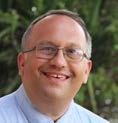
There are many interesting perspectives and insights into the texts and symbolic foods associated with the Seder Layl Pesach ,but one of the most interesting sections of the evening‘s dialogue and various rituals is the discussion regarding the’ Four Children‘.
The opening paragraph of this section of the Magid (telling of the story...) contains an interesting turn of phrase. We read:
“Kineged arba vanim dibra Torah, echad chacham, v’echad rasha, echad tam, v’echad sh’eino yodea lishol...”
“Kineged four children the Torah speaks, one wise, one wicked, one simple, and one who does not know how to ask...”
The word kineged in this context is often translated as regarding, or as referring to. The Slonimer Rebbe zy'a explained that the word kineged is actually more accurately translated to mean opposing or in contrast to. The text is telling us that the Torah speaks in contrast to many different opinions and personalities, as if to suggest that the Torah has a relevant response to diverse challenges, questions and perspectives. The Torah has a relevant eternal message for each of us, no matter our individual perspective.
We see this interpretation clearly depicted in the subsequent paragraphs describing each of the four children. There are many profound lessons and interesting themes alluded to in these few sentences.
One challenging point is that one of the children is referred to as a rasha-literally a wicked or despicable individual. This is a very strong term, much harsher than many of the familiar translations-(the contrary child, the mischievous child, etc.) connote. What is the significance of the use of the term rasha? How is it that one of the children is labeled as wicked, yet the other extreme, a tzadik, a righteous individual is not represented as being present at the Seder, rather a wise child, a wicked child, a simple child and a child that does not know how to ask?
Perhaps we might take a moment to explore and accurately define the term tzadik, before we can determine why a tzadik, is seemingly omitted from this cast of characters. There is an interesting teaching in the Mishna (Oral Tradition), the first entry in the Tenth Chapter of the Tractate Sanhedrin. There we read:
“Kol Yisrael yesh lahem chelek L’olam Habaa, sheneemar, ‘ v’ameich kulam tzadikim...”
This is classically translated as “All of Israel has a place in the World to Come, as it is written- ‘And your nation are all righteous...’”
It’s interesting to note that the letter lamed, used as a prefix in the word, L’olam, literally means to or into. The Slonimer Rebbe zy'a, clarified this teaching to mean that there are many different pathways,
50 TORAH TIDBITS 1511 / TZAV / SHABBAT HAGADOL - PESACH - SHEMINI
different portions which can lead us to the world to come. Each member of Israel has their own unique pathway, their own unique set of merits that can secure them a place in the world to come. According to the Rebbe, there are many different paths to goodness, different types of righteous individuals.
With this perspective in mind, let’s now re-visit our four children of the Seder. There are many pathways to righteousness. One pathway is through Torah scholarship. A true Torah sage personifies not only wisdom, but piety. Thus the chacham, the wise child, could potentially represent our missing tzadik.
There is also a tradition that in each generation there are 36 hidden tzadikim, 36 righteous individuals who quietly, humbly and privately go about making the world a better place. These 36 hidden righteous ones are not from among the great scholars or public leaders, rather simple, humble individuals that quietly leave a lasting imprint upon all those who are fortunate to come in contact with them. Perhaps our tam, our simple child, personifies such an individual, not, as it would appear, someone who is limited in their intellectual achievements, rather someone who quietly contributes to the good of mankind, in simple humility. So perhaps, the tam too could represent our missing tzadik.
Another sign of piety is the capacity to remain particularly careful with the mode in which we communicate and interact with others. All too often, people find themselves asking cynical, inappropriate or condescending questions. The Amshinover Rebbe zy'a posits that perhaps the
For Rent: On HaPalmachgreat 4 room apartment, 92m plus large garden in use, exclusive. 9100 shekel/month

Smadar 050-3114040 // 02-642-4329
smadi_bida@walla.co.il
Orit Madar,Adv. Family Law and Mediation Divorce, Child support, Custody Inheritance & Wills

Yariv Madar, Adv Bodily Injuries, Medical Malpractice Civil Litigation
10 Hillel St., Jerusalem | 36 Dam hamkabim st., Modiin 02-6255592, 050-3202909 Madar@netvision.net.il

OU ISRAEL CENTER 51
ENGLISH SPEAKING LAW FIRM
she’eino yodea lishol, is not the child who does not know how to form a question to be asked, rather the child who does not know how to ask the types of challenging questions which could insult or embarrass another human being. This child is not immature, rather, the most mature, a child who cannot bring himself to impugn the status or reputation of another person. Perhaps it is this child who personifies the highest level of righteousness.
Ok, so maybe each of these three children represents a certain profile that could be categorized as being a tzadik. But that still leaves us with a lingering question. What is the rationale behind the harsh label used to depict the remaining child, the rasha, the wicked child? How could our Sages have used such a harsh label in their depiction of a child?
There is a beautiful custom attributed to the Chasidic Master Rebbe Mendel of Rimanov zy'a(as cited in the important work Eim Habanim Semeicha, written by Rabbi Yissacher Shlomo Teichtel zy'a). When it came to the recitation of this section of the Hagada, the Rebbe of Rimanov refused to refer to the second of these children as the rasha. In fact, tradition has it that the Rebbe actually crossed out the word rasha in his text, and replaced it with these two words written in the column of the page-bein hasheini; literally the second child, or the different child, the child with a different perspective than all the others.
The Belzer Rebbe zy'a, taught a similar idea, based on the actual Hagada text. Included in the response to the rasha, is the instruction:
‘Hakeh et shinav...’literally, ‘strike out, push forth his teeth...’
Many interpret this to mean that we hold nothing back; we are to be firm and strong in our reply to this child. However the Belzer Rebbe offered a slightly more creative interpretation. Hakeh et shinav, not push forth his teeth, rather push forth the shin, the middle letter of the three letter word rasha. When we remove the middle letter shin from the word rasha, we are left with the two outer letters reish and ayin, which together spell the word ra, bad or evil.
The Belzer Rebbe taught, hakeh et shinav, means push forth his shin, bring out his inner self, so we’re left to recognize that this child is only outwardly ra, his outward appearance is wicked, but his essence is personified by the letter shin. The letter shin, is composed of three stems, which the Rebbe suggests, represent Abraham, Isaac and Jacob. We are thus instructed, when that challenging, outwardly “bad” child is present at the Seder- find a way to bring forth his essence, find a way to reconnect this child to the relevance of the very message of Pesach, the incredible gift of Freedom, and the enrichment that Torah can bring to each of our lives.
The Hagada's Four Children, and really the entire Seder experience is full of symbolism. Essentially we are meant to realize that throughout our history there have always been different pathways to finding meaning and growth within our tradition, that even those that seem furthest removed can also find that inspiration which is alive innate within each of our hearts, and that each of us, no matter where we are
52 TORAH TIDBITS 1511 / TZAV / SHABBAT HAGADOL - PESACH - SHEMINI
physically, professionally, or emotionally, can find true freedom- freedom to really bring forth our inner self through the eternal relevance of Torah.
May each of us be blessed to truly celebrate the beauty that is Freedom, and may this be the year that brings us to see the redemption that the Jewish People have longed for ever since that very first Pesach as we went forth from Egypt.
Be’er Tziporah a"h - Bottled Water Gemach

Walking down King George St. in Jerusalem and want a cold bottle of water?
Come help yourself to a bottle at 52 King George.
In loving memory of Yoni’s wife
Tziporah a"h, a true Eishes Chayil, always full of chessed, kindness and laughter, and brought life and strength to so many people, that she touched! She was like Aron, who loved peace and pursued peace.

Yoni thanks Hashem for having the opportunity of having Tziporah in his life, to learn of her caring, patience and happiness, to overcome her challenges. May Tziporah's Neshama be a light onto the world, in a time of darkness, and may her Neshama shine to Gan Eden. Yoni misses Tziporah with tears in his eyes, as Hashem gave him a gift, a crown jewel, now he returns her to Hashem. With thanks and Toda. Love, Yoni
To help refill the supplysend tax deductible donations for Be’er Tziporah a"h Bottled Water Gemach to Chabad of RechaviaRabbi Yisroel Goldberg email Rabbi@JerusalemChabad.org 02 800-1717
www.JerusalermChabad.org/DonateShekels


OU ISRAEL CENTER 53
בוט יכ 'הל ודוה


54 TORAH TIDBITS 1511 / TZAV / SHABBAT HAGADOL - PESACH - SHEMINI


OU ISRAEL CENTER 55
www.ou.org/sefirah
SEFIRAT HAOMER 2023/5783

Sign up for the OU daily sefirah reminder email @ www.ou.org/sefirah
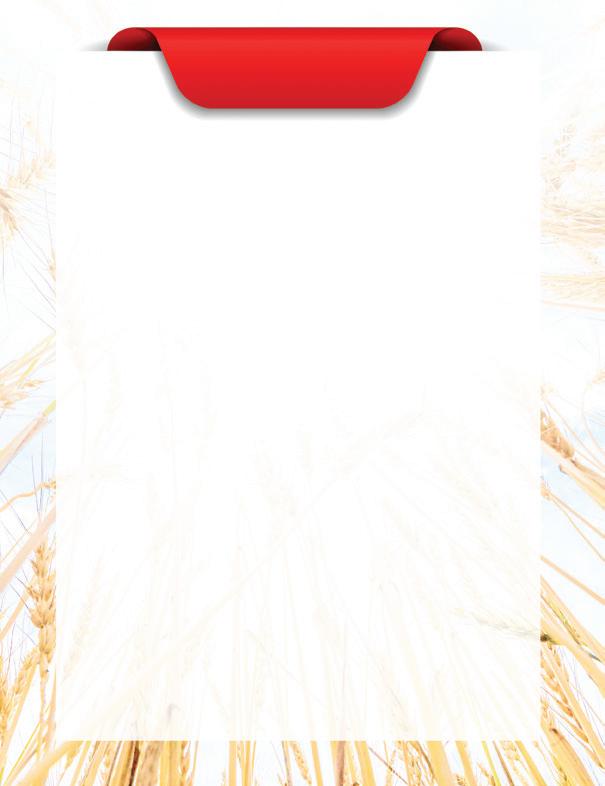
Sefirah is the counting of seven complete weeks from the second evening of Pesach until Shavuot. The count, which takes place after nightfall for the following day, is preceded by the blessing only if done in the evening and no days have been missed in the count.
Visit www.ou.org/sefirah to receive an email reminder to count each day. Emails are pre-programmed to go out on each of the 49 days of the Omer to help make sure you don’t forget to count!
NOTE: IF YOU FORGET TO COUNT AT NIGHT, YOU MAY COUNT ALL OF THE NEXT DAY – BUT WITHOUT A BLESSING YOU MAY RESUME COUNTING THE NEXT EVENING WITH A BLESSING.
56 TORAH TIDBITS 1511 / TZAV / SHABBAT HAGADOL - PESACH - SHEMINI
FRI. EVENING APRIL 7 2 SAT. EVENING APRIL 8 3 SUN. EVENING APRIL 9 4 MON. EVENING APRIL 10 5 TUES. EVENING APRIL 11 6 WED. EVENING APRIL 12 7 THURS. EVENING APRIL 13 8 FRI. EVENING APRIL 14 9 SAT. EVENING APRIL 15 10 SUN. EVENING APRIL 16 11 MON. EVENING APRIL 17 12 TUES. EVENING APRIL 18 13 WED. EVENING APRIL 19 14 THURS. EVENING APRIL 20 15 FRI. EVENING APRIL 21 16 SAT. EVENING APRIL 22 17 SUN. EVENING APRIL 23 18 MON. EVENING APRIL 24 19 TUES. EVENING APRIL 25 20 THURS. EVENING APRIL 6 1






















OU ISRAEL CENTER 57 www.ou.org/sefirah WED. EVENING APRIL 26 21 THURS. EVENING APRIL 27 22 FRI. EVENING APRIL 28 23 SAT. EVENING APRIL 29 24 SUN. EVENING APRIL 30 25 MON. EVENING MAY 1 26 TUES. EVENING MAY 2 27 WED. EVENING MAY 3 28 THURS. EVENING MAY 4 29 FRI. EVENING MAY 5 30 SAT. EVENING MAY 6 31 SUN. EVENING MAY 7 32 MON. EVENING MAY 8 33 TUES. EVENING MAY 9 34 WED. EVENING MAY 10 35 THURS. EVENING MAY 11 36 FRI. EVENING MAY 12 37 SAT. EVENING MAY 13 38 SUN. EVENING MAY 14 39 MON. EVENING MAY 15 40 TUES. EVENING MAY 16 41 WED. EVENING MAY 17 42 THURS. EVENING MAY 18 43 FRI. EVENING MAY 19 44 SAT. EVENING MAY 20 45 SUN. EVENING MAY 21 46 MON. EVENING MAY 22 47 TUES. EVENING MAY 23 48 WED. EVENING MAY 24 49

58 TORAH TIDBITS 1511 / TZAV / SHABBAT HAGADOL - PESACH - SHEMINI

OU ISRAEL CENTER 59

60 TORAH TIDBITS 1511 / TZAV / SHABBAT HAGADOL - PESACH - SHEMINI

OU ISRAEL CENTER 61


62 TORAH TIDBITS 1511 / TZAV / SHABBAT HAGADOL - PESACH - SHEMINI



OU ISRAEL CENTER 63


64 TORAH TIDBITS 1511 / TZAV / SHABBAT HAGADOL - PESACH - SHEMINI
Please note the updated mailing address for the OU Israel Center: OU Israel
22 Keren Hayesod
POBox 1441 Jerusalem 9101302 ...
המלש האופר



•Yosef Ezriel ben Chaya Michal
הלחמ ןב ןתנוהי •
רתסא ןב המלש •
הכרב הנח ןב השנמ םהרבא •
• Esther Fruma bat Baila
• Yisrael Leib ben Chana
• Chana Bat Bruriah
• Chaim Moshe Ben Leah
DOROT - The OU Women's Intergenerational Choir Director Hadassah Jacob 052-384-7230


Monday Evenings 7:00 - 9:00pm
PRI HADASH
WOMEN'S WRITING WORKSHOP AT THE OU ISRAEL CENTER
Resumes April 24th


Monday mornings 10.30-12.30
For more details, call Ruth 02-628-7359 or Judy 054-569-0410
DOWNLOAD YOUR FREE
ISRAEL.NCSY.ORG/HAGGADAH2023
COPY AT
GEULAS YISRAEL
BY RABBI MOSHE TARAGIN R am, Yeshivat Har Etzion
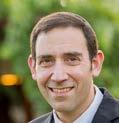
It Will Take Time
Shir Hashirim portrays Hashem’s arrival in Egypt through the metaphor of a gazelle leaping and bounding across the mountains. This energetic image conveys excitement and affection, but most of all, speed.
Everything in Egypt was moving at warp speed. Our 400-year sentence of slavery was commuted to a 210-year term. The night of the actual Exodus was even more frenetic as Hashem descended at midnight, and within hours we were already commencing our desert voyage. Everything was moving so quickly that we couldn’t even bake bread for the journey, instead gathering scraps of unbaked dough and quickly wrapping them in clothing. A mad dash from Egypt.
Our lightning fast escape from Egypt is distilled by the term ןוזפח, a word which appears twice in the Torah. The gemara in Berachot asserts that both Egyptian and Jew experienced a similar chipazon pace, and for this reason the word appears twice.
The Egyptians were overcome by Hashem’s overwhelming force, and they frantically expelled us out from Egypt.
Days earlier, a defiant Pharo had cautioned Moshe that their next encounter would mark Moshe’s untimely death. At this stage, facing the onslaught of makkat bechorot, the humbled and frightened tyrant desperately searched the streets of Egypt, begging him to quit Egypt and end the bloodbath. Everything was going sideways and in a hurry and no one had time for procedure or order. The Egyptians were caught in a panicked frenzy.
This panic was ironic, as Hashem’s punishment of the wicked always is. Egypt had always been a country of planners. They had pieced together a plan to store food during years of agricultural prosperity, to better survive the upcoming famine. Likewise, they had deviously schemed a methodical subjugation and slavery of an entire Jewish nation. This night, all their tactics and strategies went out the window as Hashem descended into Egypt and wrecked the best laid plans of Man. Egyptian chipazon signaled the futility of human planning when it opposes the moral will of Hashem.
Jewish Chipazon
We too, experienced a whirlwind exit from Egypt. The breakneck pace of our geulah reflected the purely divine nature and texture of our redemption. During the preliminary stage of our geulah- during the negotiations with Pharo and subsequent plagues- Hashem opted to stream geulah
66 TORAH TIDBITS 1511 / TZAV / SHABBAT HAGADOL - PESACH - SHEMINI
לע ץפקמ םירהה לע דלגמ אב הז הנה ידוד לוק תועבגה
PESACH
through Nature and through politics. He could have easily lifted us out of Egypt without Pharo’s approval, but He wanted geulah to flow through history and through human decisions.
This night however, was different. We were confined to our homes and Pharo was reduced to a bumbling and babbling coward. There was little human about this night, as the stage was cleared for Hashem to make His first appearance in the human realm.

חילש ידי לע אלו ףרש ידי לע אלו ךאלמ ידי לע אל ומצעבו ודובכב ה”בקה אלא

This was not an evening for human agency or for divine proxies dispensing the will of Hashem. This night, all human conventions, including human time and

human schedules. Our chipazon was a product of a divine tempest swirling through Egypt.

A Slower Pace
Egypt happened quickly, but our current redemption will be slower. In chapter 52 Yeshayahu cautions that our final geulah will be paced more slowly than our first redemption from Egypt.
םכינפל ךלוה יכ ןוכלת אל הסונמבו וכלת ןוזפחב אל יכ לארשי יקלא םכפסיאמו ’ה
Unlike the rapid redemption from Egypt, our final redemption will not occur in chipazon-like haste. Though Chazal allude to a possibility of a quick and rapid final redemption, it is far more likely though that our final redemptive process will unfold gradually and slowly. We will return to Israel, but many will, initially, remain behind in exile. We will lay claim to our
67
1898 **************** RESTORE YOUR FURNITURE TO HEALTH **************** Website: www.thefurnituredoctor.co.il Email: office@thefurnituredoctor.co.il
WhatsApp:
3755
Phone: 02-999-2418
058 787
125th YEAR ANNIVERSARY THE FURNITURE DOCTOR WISHES ALL OF OUR PAST, PRESENT & FUTURE CUSTOMERS & THEIR FURNITURE A HAPPY & HEALTHY PESACH
COMING SOON - THE FURNITURE DOCTOR'S LOYALTY PROGRAM COMING SOON - THE FURNITURE DOCTOR'S LOYALTY PROGRAM COMING SOON - THE FURNITURE DOCTOR'S LOYALTY PROGRAM + NEW PRODUCTS. + NEW PRODUCTS. + NEW PRODUCTS. CHECK OUR WEBSITE & FUTURE ADS FOR FURTHER DETAILS CHECK OUR WEBSITE & FUTURE ADS FOR FURTHER DETAILS CHECK OUR WEBSITE & FUTURE ADS FOR FURTHER DETAILS
ancient homeland, but the world will not immediately recognize our rights. Unlike the chipazon geulah from Egypt, our final geulah will take time.…in more ways than one.
Internal Geulah
It is clear that the international and diplomatic component of redemption will be gradual. Settling all of Israel and earning international approval will not be immediate. The return of the children of God to the land of God will arouse much disapproval and denial of our rights. This is obvious.
What is less obvious is that our internal geulah process will also take time. Redemptive fever breeds unrealistic expectations. We assume that, immediately upon our return, all internal issues will be easily and effortlessly resolved. We have learned the hard way, that unifying Jews from across the globe and from different religious orientations is not as simple as it sounds. We face a battery of social, cultural, and religious challenges which are probably too thorny for quick and simple solutions. Without patience and vision, we cobble together clumsy and ineffective solutions and become frustrated in the long term. Redemption requires faith and passion, but also patience and stamina. It is hard to juggle passion and patience. They don’t naturally cohere.
Rav Kook’s vision is not happening. Secular Zionism does contain a seed of teshuva and will, one day, sprout into a religious revival. But it doesn’t seem to be happening quickly. There has been a recent and welcome shift in secular Israeli society toward traditionalism or masoratiyut, but a full religious awakening still seems distant. This process will take time and we must learn to model the beauty and nobility of religion rather than aggressively force-feed religion through legislation and enforcement. Imposing religion upon unwilling recipients always backfires in the long run.
The Conversion Dilemma
Israel was built as a safe-haven of return for every Jew alive. As various countries around the world are plunged into political turmoil, and given the rising tide of antisemitism, the rate of Jews returning has increased. However, not everyone who returns home is halachically Jewish. We embrace every person who strongly affiliates with our nation, but we must not relax halachic standards of conversion. Opening the door to every person who identifies as Jewish but is not will contaminate the Jewish pedigree we fought so hard to preserve over a two-thousand year exile in foreign lands. Finding a solution to this prickly dilemma will take time and will probably not occur in our generation. Redemption takes time- both externally and internally. Living through redemption requires patience and faith.
Charedim and Demography
Torah study is paramount to Jewish identity and without it we lose our title to this

68 TORAH TIDBITS 1511 / TZAV / SHABBAT HAGADOL - PESACH - SHEMINI
Gemach for Chatan and Kalla: Meals for wedding and Sheva Brachot at cost Eida Hachareidis Hechsher Tel:052-633-1744 gadgadood@gmail.com
land. Additionally, our Torah commitment protects us from foreign threats. Charedi society is built upon massive investment in Talmud Torah through isolation from broader cultural and economic engagement. Charedi society insulates itself to better protect itself against a modern cultural barrage which threatens religious purity. This separatist approach worked for many decades, while Charedim lived on the fringes of society.
Demographics are quickly changing and charedim are achieving political clout. A situation where such a large demographic lives apart from general society, but still influences it is a ticking time bomb– for both secular Israelis and charedim. How can charedi society integrate in a manner proportionate to its demographic, without compromising its ideals? Sadly, secular Israel still harbors hostility to a charedi culture which it sees as shirking national service, while attempting to superimpose religious standards upon mainstream society. How can we stitch together these various stands of Israeli society into one cohesive fabric? This too will take time and trial and error.
So, over Pesach celebrate the “lightning in a bottle” redemption from Egypt. Celebrate the evening that human timelines were ransacked and Hashem Himself choreographed a rapid redemption. But don’t expect an encore. We are back in history and back in our land. Our dark world has been illuminated by the rays of redemption. But it will take time and it will not all happen in our generation. It may, but don’t count on it.
Chag Kasher v’sameach






OU ISRAEL CENTER 69
collectables,
antiques
ל רודמ רוד
054-5561223
One person’s trash is another person’s treasure… We buy old sifrei kodesh, judaica gold, silver, coins,
banknotes,
and more…
Ran:
Gilinski Real Estate gilinski.co.il French Hill 4R, 90 SQM, 6th floor, renovated, accessible, divided into 2 apts. #050-3362306 2,685,000 NIS Old Katamon 3.5R, 60 SQM + 2 galleries, garden, storage, parking. #050-7225694 Arnona 3R, 88 SQM, 5th floor + elevator, balcony, storage, parking. #050-7225694 3,150,000 NIS 2,800,000 NIS Flying Soon? Travel with Confidence 1UniTravel - Medical Insurance at great prices Choose from multiple options 1unitravel.brokersnexus.com 1UniSim - Sims for USA and Worldwide Starting at $40 sales@1unisim.com Call 077-400-3199 or USA 718-715-0001
Editor, Torah Tidbits


Meditative Potential In the Land
The imagination of the Land of Israel is pure and clear and suited for the appearance of the divine truth…The imagination that is in the Lands of the Nations is murky, mixed with darkness, with shadows of impurity and pollution. (Eretz Chefetz 4:5)
Perhaps Rav Kook’s words above can be best elucidated by spotlighting the life of one of Rav Kook’s closest colleagues. The legendary figure of Jerusalem, Rabbi David Cohen, famously known as ‘the Nazir’ of Jerusalem. Rabbi Cohen first met Rav Kook in Switzerland and then reconnected with his spiritual master in the Land of Israel. Upon his arrival to the Land of Israel, Rav Cohen adopted ascetic practices, crowned by a Nazarite vow - a lifelong abstention from all grape products and from cutting his hair. He also became a vegetarian, did not wear leather shoes, and maintained a ta’anit dibbur (refraining from speaking) for forty days from the beginning of the month of Elul to after Yom Kippur.
In his classic volume Kol ha-Nevuah (Jerusalem 1969) the Nazir sets out to present a path towards achieving prophecy. He advocates for hitbodedut in the hills surrounding
Jerusalem, emulating the spiritual wanderings of the biblical prophets. To the Nazir, the text-less hitbodedut in nature reflects the return to the prophetic culture of Israel.
(See “The Nazir in New York,” The Seforim Blog, Josh Rosenfeld)
The Nazir would often quote the call of Rav Kook: “To the wellsprings of Prophecy we are called.” The Nazir believed that the salvation of Israel would not be actualized without a spirit of holiness that ushers in the attainment of prophecy. (‘The Legacy of the Nazir,’ Rechnitz Edition, p.16)
The Nazir’s son, Rabbi Shaar Yashuv Cohen, described an unusual and somewhat mysterious episode that took place between his father, the Nazir, and Rav Kook:
“Once I was told by one of the Torah greats of Israel, that he once entered the house of Rav Kook in the time of the month of Elul, and found Rav Kook and my father intensely involved in the particularities of blowing the shofar. My father blew the shofar and then Rav Kook blew the shofar. They were blowing the shofar in accordance with secretive mystical intentions - the kavanot of B’nei Hachalah (Members of the Sanctuary who long to see the glow of the Miniature Presence).” Apparently,
70 TORAH TIDBITS 1511 / TZAV / SHABBAT HAGADOL - PESACH - SHEMINI
RABBI AARON GOLDSCHEIDER
PESACH
donated by Marion & Michael Silman Ita Rochel 02-560-9125
their intentions were to bring closer the final redemption. Although this episode is a mystery, in some form, they were blowing the shofar, which symbolizes the shofar of Mashiach, alerting the world to his arrival.




The Nazir collaborated with Rav Kook on organizing his worldview in the books “Orot HaKodesh.”

In chapter 138 (Vol. One) of that work which elaborates on the topic of holiness, Rav Kook writes: “The branches of prophecy grow and the children of prophets wake, the spirit of prophecy goes and travels through the Land…and the special higher quality of Israel, knows the spirit of God that will be revealed only in His Land.” (Ibid. p.17)
The Nazir’s Silence, A Path to Prophecy
The Nazir was known to take periods of time when he refrained from speaking. It



OU ISRAEL CENTER 71
Premiummoving.co.il 053-7272-815 PREMIUM MOVING & STORAGE ד"סב
is well known that his custom during the 40 day span from the first of the month of Elul through Yom Kippur was to practice silence. It seems that the Nazir utilized this as a method towards attaining a heightened awareness of self and being more conscious of his thoughts and a higher dimension that could potentially be accessed.
Rav Kook in his Orot Hakodesh (III, p. 274) considers the immense power of “The Higher Silence” :
“Silence will be sought from the depths of a soul which is regularly devoted to higher contemplation that transcend man’s capacity for verbal articulation. When a person with a sublime soul pursues his exalted silence, many worlds are fashioned, noble songs rise with their holy tribute [to God], and a higher force with holy delight is raised over all spheres of the spiritual.
Silence, which abounds with life, gathers within itself the majesty of wisdom. The spiritual and practical worlds, with all their well-defined particularities, in their most precise formulations, reveal themselves with mighty force to the wise person of higher stature whose vineyard is fenced in with a fence of silence, which is appropriate for the wise. This is the higher silence that rises above the wind, the tumult, the fire, “It is a still small voice” (1 Kings 19:12), and behold God is passing” (ibid., 19:11) (translation from “The Essential Writings of Abraham Isaac Kook, Bokser, p. 187)
Again in Orot Hakodesh, Rav Kook emphasizes the role of ‘silence’ in attaining clearer Comprehension and a higher intuition (Orot Hakodesh vol. 3, p. 273). Here, to our surprise, Rav Kook suggests that the Matzah is symbolic of silence. Perhaps
Rav Kook is alluding to the idea that the Matzah’s contents consist of only the very essential ingredients, without any preservatives or additives. In the meditative state of silence, one disconnects from any interferences and diversions and is able to focus more alertly, more naturally.
The following is Rav’s Kook’s unique description of meditative silence with which he sees symbolized by the Matzah:
“The Special Quality of Silence: The special quality of silence and the spirit of holiness that attaches itself to you via silence emerges from an inner bursting forth. The bursting forth emerges from the midst of the wellspring of your soul, which seeks a great arena in which to spread out and broaden, without constriction…Matzah silences all superficial uproar, all movement and self-elevation in the framework of life. It mutes the superficial currents. This comes as a twin to the revelation of God’s presence and a great fear that descends to the depth of the secret of silence. It expresses itself in a glorious voice to which silence attaches itself. ‘The Pesach sacrifice that one eats is the size of an olive. Yet one’s Hallel resounds as though the roof would burst forth’ (Pesachim 88b).” (Orot Hakodesh 3, p. 273)
72 TORAH TIDBITS 1511 / TZAV / SHABBAT HAGADOL - PESACH - SHEMINI
Internal Medicine and Geriatrics Certified Specialist in the US and Israel Former faculty member, Johns Hopkins University Adult Medical or Geriatric HOME VISITS 058-323-1966 dr.ybarron@gmail.com (Not Kupat Cholim Leumit)
Dr. Yirmiyahu Barron, MD


OU ISRAEL CENTER 73 3 is the addressof SherlockS Hat Store – Dorot Rishonim 3 WHO KNOWS 3? WHO KNOWS 5? WHO KNOWS 17? NOW YOU KNOW 5 are the days of the SherlockS SALE – April 5,7,9,10,11 17 is the percentage of SherlockS DISCOUNT – Hats and Caps Dorot Rishonim 3, Jerusalem Tel: 02 563-7155 Website: SherlockSHats.com
10-8, Fri – 10-2 “If The Hat Fits It’s SherlockS!”
Sun-Thrs
TOWARDS MEANINGFUL TEFILLA
BY REBBETZIN ZEMIRA OZAROWSKI Director of OU Israel L’Ayla Women’s Initiative

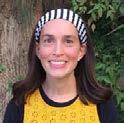
Hallel at the Seder
It’s finally the end of Maggid, and the only thing on everyone’s mind is – it’s time to eat!! We’re finally up to the second cup of grape juice, Matza, Maror and the meal. But before we get there, we pick up our cups and say
now that we’ve finished re-telling the Pesach story, we are obligated to recite Hallel. We then proceed to recite the first two paragraphs of the Hallel. Many of us at this point are not very focused on what we are saying. But the truth is that this is really not a good time to tune out and think about food, as we have just reached the climax of Maggid. These paragraphs are actually the entire goal of the seder! It’s the litmus test to see whether we have done Magid successfully.
What do I mean by this?
We just finished saying
in every generation, a person is obligated to get to the point where he feels as if he himself left Mitzrayim, as if he personally experienced Yetziat Mitzrayim. We do this by acting out the scenes, by going through the Pesukim, by retelling the story as vividly as possible, and by using all sorts of sensory props – the foods, the dipping, the leaning etc. And if we did it all right the result is םיבייח ונחנא ךכיפל ללהלו תודוהל - the need to say Hallel!
We now proceed to recite the first two paragraphs of Hallel. There are many things that are very strange about this Hallel:
Generally, Hallel needs to be said during the day and not at night! The Gemara in Megilla 20b learns this from two different pesukim that we recite in the Hallel – חרזממ ואובמ דע שמש (from sunrise to sunset) and הז ה השע םויה' (this is the day that Hashem performed for us)
Usually women are exempt from Hallel because it’s a אמרג ןמזהש השע הווצמ (a timebound positive Mitzvah). Yet women are obligated in the Hallel of the seder!
The Shulchan Aruch (422:7) poskuns that we are normally obligated to say Hallel standing up. This is because we are giving testimony to the miracles that Hashem has done for us in the past. And yet, at the Seder we say Hallel sitting down!
We always say Hallel with a Bracha and here we skip the Bracha!
And finally - Why do we split the Hallel

74 TORAH TIDBITS 1511 / TZAV / SHABBAT HAGADOL - PESACH - SHEMINI
ללהלו תודוהל םיבייח ונחנא ךכיפל
-
םָדָא בָּיַח רֹודָו רֹוּד לָכְּב םִיַרְצִּמִמ אָצָי אּוה ּוּלִאְּכ ֹומְצַע תֶא תֹואְרִל
–
PESACH
up and only recite the first two paragraphs here and the rest after we eat?
The answer is that this is a very different type of Hallel than the one we are used to. During the rest of the year, when we recite Hallel, we are thanking and praising Hashem for a miracle He performed for our ancestors many years ago. But this is a different kind of Hallel – it’s a הריש לש ללה, it’s a Hallel of thanksgiving for a tremendous miracle that just occurred this instant! At the Seder, we are not supposed to be merely commemorating and remembering a miracle that happened thousands of years ago, we are supposed to feel that we personally have experienced that miracle right now! Rav Hai Gaon writes "'ןירוק' תרותב ותוא ןירוק ןיא הריש רמוא' תרותה אלא' – This Hallel doesn’t fall under the general parameters of ‘reading Hallel’ but rather in the parameters of ‘singing praise’. Since this is a different type of Hallel, all the rules that we mentioned above no longer apply,
It’s okay to recite this Hallel at night and sitting down, because right now is when we are experiencing the miracle. This Hallel is a spontaneous reaction, and so we don’t place rules and limits on our emotional reaction. Women are included in this Mitzvah because they themselves are experiencing the miracle. We don’t make a Bracha on this Hallel because if I say a Bracha, that indicates that I am reciting Hallel because I was commanded to, it’s a premeditated act. This Hallel is supposed to be an
NEW SONY PHONE -50% SALE With Extras. Full Information. Sony Xperia, BlackBerry, Razer, LG David Tel/Text 052-544-8695
rotenbergdavid1@gmail.com

is reluctant to send Yishmael away and Yitzchak seeks reconciliation with Yishmael and seeks to bless Esav.
automatic reaction. And finally, the reason we say only part of the Hallel right now is because this is ירצמ ללה – the section of hallel that is relevant to Yetziat Mitzraim and what we would expect people who really felt they left Mitzrayim to say. (לארשי תאצב םירצממ etc)
6th Aliya (25:1-11) Avraham marries Keturah; they have 6 sons. All that Avraham has goes to Yitzchak; these are sent eastward with gifts. Avraham dies at age 175; he is buried by Yitzchak and Yishmael in Ma’arat Hamachpelah. Yitzchak is blessed by G-d: he lives in Beer L’chai Roi. The transition from Avraham to Yitzchak is complete. While G-d has been a silent partner in this parsha, here He completes the generational transfer – He blesses Yitzchak. The Jewish people will be Yitzchak and not Yishmael.
So as we discussed in the beginning of this article – this Hallel is the litmus test as to whether or not I was successful in my Magid. If by the time I get to the Hallel, I am bored, hungry, tuning out, and just mouthing the words because that’s what my Haggadah tells me to do, then I was not very successful. But if I have reached the climax here, where I am living the slavery and then the miracles of the redemption, and I burst out in song of thanks to Hashem, then I have been successful in my Magid.
7th Aliya (25:12-18) The generations of Yishmael are enumerated. Yishmael dies. His descendants dwell from Egypt to Assyria. Yishmael’s story is brief. He has numerous and powerful offspring. The brevity
In both the paragraph before and after these two paragraphs of Hallel, we call the Hallel a השדח הריש, a new song. Why is this Hallel called a new song, if we’ve actually said Hallel many, many times before? Rav Yosef Tzvi Rimon answers that the difference is not in the words that we say but how we feel when we say them. Every year, we get a little closer to feeling the redemption and the emotions behind the song are different, so in essence it comes out as a “new song”.
interested the Jewish length. echoes tions woman and began father’s that his icant the
A SHORT VORT
BY RABBI Rav, Beit Knesset
When Avraham addresses the people of Cheit, trying to “Ger V’Toshav Anochi Eimachem” (23:4) “A Stranger and This seems to be a contradiction. If one is a stranger than is no longer a stranger. What did Avraham mean?
The Magid of Dubno (Jacob ben Wolf Kranz 1741-1804) this tense situation in order to, both, state his truth and be said, on the one hand, “I am a Resident’ due to G-d’s promise need your agreement to purchase a plot. In other words, Avraham “strangers”, while they understood him as saying that “they” The peace was kept, and Avraham remained true to his Shabbat Shalom
May we all be zocheh to really achieve this level and to say Hallel with true excitement and fervor, and may our Hallel (and Magid experience) get better every single year.
OU ISRAEL CENTER 75
12 TORAH TIDBITS 1440 / CHAYEI SARA 5782
is
FROM THE VIRTUAL DESK OF THE
OU VEBBE REBBE
RAV DANIEL MANN
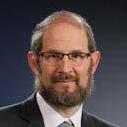
Mechirat Chametz and Tevillat Keilim
Question: I never do tevillat keilim after Pesach on keilim I sell. Can that be justified?

Answer: Your excellent question has been bothering Acharonim for centuries. If one follows the apparent consequences of mechirat chametz, the relevant keilim should require tevilla because when a Jew sells a kli to a non-Jew and buys it back, it needs tevilla (Shulchan Aruch, Yoreh Deah 120:11). The determinant, regarding both stringency and leniency, is non-Jewish ownership, not his physical contact with the kli (ibid. 10-11). In fact, we take significant steps to ensure the chametz is halachically sold to the non-Jew (see Mishna Berura 448:12).
So maybe we should just do tevilla? While a handful of people do such a tevilla (it would be without a beracha – Yabia Omer VI, YD 11), the very broad minhag is not to do tevilla. The need for leniency is clear. If one sells all of his chametzdik keilim, it is a lot of work; if he sells just those it is hard to clean, the daunting problem is that a kli must
be without chatzitzot for the tevilla to work (Shulchan Aruch, YD 202).
What is the mechanism for leniency? The straightforward approach is to not sell keilim that require tevilla. One does not need to sell a clean chametzdik utensil, as the prohibitions to possess chametz (= bal yeira’eh …) and the resulting chametz she’avar alav haPesach (=chshahp) apply only to chametz that is b’en (roughly, intact), not that which is absorbed in a kli (Pesachim 30a; Shulchan Aruch, Orach Chayim 451:1). Any mechirat chametz contract that refers to selling particles that are absorbed in keilim is employing extreme chumra, and it is far from clear one can even sell them (see Mishpat Hamechira II:4:4).
A more reasonable problem relates chametz that is b’en but is difficult to remove (see Shulchan Aruch, OC 442:11), which can be the subject of bal yeira’eh. Some recommend selling only the stuck-on chametz without the kli (Shut Chatam Sofer I:109). The problem is that it is questionable if and how one can sell something while it is in the seller’s utensil (see Shulchan Aruch, Choshen Mishpat 200:5). Therefore, some require to sell the keilim also (Ben Ish Chai I, Tzav 9). There are two alternatives to selling these keilim: 1. Rent out the keilim to the non-Jewish buyer, while selling the chametz stuck to them, which many say solves the acquisition problem (see Mishpat Hamechira ibid.). 2. Make sure the remaining chametz is totally
76 TORAH TIDBITS 1511 / TZAV / SHABBAT HAGADOL - PESACH - SHEMINI
תמשנ
ל"ז
לאיזוע
PESACH
יוליעל
ןמצלז
םהרבא ןב םירפא לאוי
The Orthodox Union - via its website - fields questions of all types in areas of kashrut, Jewish law and values. Some of them are answered by Eretz Hemdah, the Institute for Advanced Jewish Studies, Jerusalem, headed by Rav Yosef Carmel and Rav Moshe Ehrenreich, founded by HaRav Shaul Yisraeli zt”l, to prepare rabbanim and dayanim to serve the National Religious community in Israel and abroad. Ask the Rabbi is a joint venture of the OU, Yerushalayim Network, Eretz Hemdah... and OU Israel’s Torah Tidbits.







inedible (see Shulchan Aruch, OC ibid.).



One who wants to avoid selling keilim must check the mechirat chametz text he is signing. Some are very broad, and include even chametz and keilim one does not realize he is selling. You can shop around for a less inclusive text or specify in your personal form that you are selling only things you put in the assigned places. If you do that, you will have chshahp problems if you failed to put in its place something that needed to be sold (see Living the Halachic Process III:D20). (It is unclear to what extent one can rely on selling chametz one did not know about; the classic mechanism for such items is bitul chametz (see Pesachim 4b, 6b).)
There are poskim who approve of selling chametzdik keilim and not doing tevillat keilim. Haelef Lecha Shlomo (YD 193) says that mechirat chametz, as a “deception,” is only effective enough for the chametz because we have bitul chametz as a fallback and not valid enough a sale to require tevilla for the keilim. The Aruch Hashulchan
NACHI REALTY 054-461-3943
For Sale - Last 2 room apartment + mirpeset & underground parking in new building under construction in a great location. 2.15m shekel. 3 & 4 rooms also available
For Rent in a brand new building in the City Center, 4 rooms. 102m, amazing views to the Temple Mount, Shabbat elevator, parking and 9m mirpeset, 12,000 shekel
For Rent in the German Colony on Emek Refaim street, 2 rooms, one floor up, good shape, parking. 4,600nis/month
(YD 120:52) takes the same basic approach, that we do not need a full sale, but explains that even to the extent the non-Jewish buyer owns the keilim, it does not require tevilla because “the name of the non-Jew is not upon it.” These ideas are plausible but their weakness is self-evident (see Mishpat Hamechira ibid.)









I personally prefer limiting the scope of mechirat chametz to what is needed, as extreme chametz chumra creates the need to rely on unusual tevillat keilim kula. However, one may simply follow his rabbi’s mechirat chametz system and not do tevillat keilim thereafter.


OU ISRAEL CENTER 77 Having a dispute? For a Din Torah in English or Hebrew contact ‘Eretz Hemdah - Gazit’ Rabbinical Court: 077215-8-215 • fax: (02) 537-9626 beitdin@eretzhemdah.org
Distributed throughout Israel Hechsharim & to order: www.MatzaMan.co.il hillel.leib@MatzaMan.co.il
Spelt, GF Gluten Free Oat Hand & Machine.
Passing on Our Memories
Our Sages tell us that we were redeemed from Egypt on the merit of the righteous women. The men in Egypt were enslaved, both physically and mentally; their morale was extremely low, as it seemed that there was no hope and no prospect of ever leaving Egypt. In addition, Paro had given the midwife's explicit instructions to kill all the male children, and, when they disobeyed his orders, he simply commanded his servants and soldiers to go and find Jewish male babies and kill them.
Jewish men were distraught, asking themselves whether it was even worth it to continue having children, who would inevitably die at the hands of their cruel Egyptian masters. They separated from
their wives, stopped having children, and waited for the fateful demise of the Jewish people. Had the men had their way this would be the end of the children of Israel, who would have perished before we could become an independent nation.
But the women had a different attitude; they were not willing to surrender to the evil decree, they refused to succumb to the sadistic ruler of Egypt. They enticed their husbands and continued to give birth to boys and girls. Many were killed and some were able to get away, but the Jewish people as a whole survived, due to the tenacity and determination of Jewish women.
While the Midrashic story highlights the achievements and unswerving faith of our incredible Jewish women, it also emphasizes that the future of the Jewish people is dependent on the birth of Jewish children. Without babies being born the Jewish people cannot survive.
This is the reason why Seder night is centered on children, and on passing the


78 TORAH TIDBITS 1511 / TZAV / SHABBAT HAGADOL - PESACH - SHEMINI
RABBI GIDEON WEITZMAN
Machon Puah for Fertility and Gynecology in Accordance with Halacha
PESACH Securities offered through Portfolio Resources Group. Inc., member of FINRA, SIPC, MSRB, SIFMA US BROKERAGE SERVICES IN ISRAEL Get the Best of Both Worlds Keep your money in the US and receive local expert investment advice 02-624-0995 054-599-9530 aaron@lighthousecapital.co.il www.aaronkatsman.com CALL
tradition from one generation to the next. The Torah instructs us "and you shall tell your children on that day, saying, because of this God did for me when I left Egypt" (Shemot 13:8). Seder night is about the importance of children for the continued survival of the Jewish people. It is a multi-generational experience in which the focus is on telling the new generation about the past generations, making our memory their memory.
At this time, we can give thought and prayer for couples facing fertility challenges and are currently unable to tell their children the story. We can show them sympathy and empathy, and, when appropriate, we can say a few chosen words. As we enjoy our families and tell our children and grandchildren the story, we can remember those who cannot yet pass on the tradition, that soon they will tell children of their own.
Pesach Sameach

The Puah Institute is based in Jerusalem and helps couples from all over the world who are experiencing fertility problems. Offices in Jerusalem, New York, Los Angeles & Paris. Contact (Isr) 02-651-5050 (US) 718-336-0603 www.puahonline.org




OU ISRAEL CENTER 79
BY RABBI MOSHE BLOOM en.toraland.org.il

Erev Pesach: Bi'ur Time For Shemitah Wine And Grape Juice
The laws of shemitah underline that the land and its produce do not belong to us, rather to Hashem. While we may eat the produce of the land’s Sabbatical year, it is supposed to be available to all Jews. We may take enough for our own use (one week at a time), but not stockpile it thereby preventing access to others.

Once the produce is no longer available to animals in the field, we are supposed to get rid of it as well. According to Rambam, we should either distribute any excess produce to others or actually burn it. Most posekim, however, maintain that it is possible to perform bi’ur by declaring excess produce ownerless. If no one claims the produce, we are allowed to claim it. This is most relevant to produce with long shelflife such as wine, oil, dates, and figs.
Bi’ur presents an opportunity for us consumers to internalize on a smallscale what shemitah-observant farmers feel: the wine/grape juice isn’t really
ours. Even if no one takes the bottles, they might be taken. We should declare them ownerless whole-heartedly. This will drive home the message of shemitah: everything really belongs to Hashem. This year we have the rare opportunity to perform two mitzvot of bi’ur at the same time: bi’ur chametz and bi’ur of shemitah wine.
Bi’ur procedure
On erev Pesach, bi’ur time for wine and grape juice, those who have enough for family use for three meals (including the wine necessary for the entire family for Seder night) need not perform bi’ur for the wine. However, those who have large quantities of wine should proceed as follows:
Take the wine outside of your home and declare it ownerless. If you cannot remove it from your home, bring three people to your home and declare it ownerless in their presence. It is permissible to declare the wine ownerless in the presence of three friends even if you know that they will not take the wine. After you perform the mitzvah of bi’ur, it is permissible to claim to bottles.
When declaring the wine ownerless, it needs to be stated in a way that makes it clear that it is ownerless to all. Chazal’s formula:
“Our brothers of the House of Israel: Anyone who needs to take can come and take.” After bi’ur is performed, the wine retains its kedushat shevi’it status and should be handled accordingly.
80 TORAH TIDBITS 1511 / TZAV / SHABBAT HAGADOL - PESACH - SHEMINI
לֹּטִיְו אֹובָי לֹּטִל ְךיִרָּצֶׁש יִמ לָּכ :לֵאָרְׂשִי תיֵּב ּוניֵחַא
TORAH VEHA'ARETZ INSTITUTE
PESACH




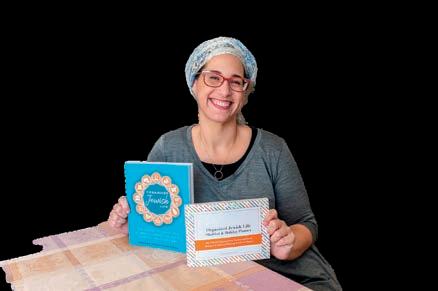

OU ISRAEL CENTER 81 be ready for every thing Pick up your copy and be prepared for every occasion and Jewish life cycle event. Checklists to help you prepare for every event @BALAGANBEGONE organizedjewishlife.com Companion Shabbat & Holiday Planner online at amazon.com or in Israel exclusively at Makes a great gift

82 TORAH TIDBITS 1511 / TZAV / SHABBAT HAGADOL - PESACH - SHEMINI PESACH
For Sale
A rare opportunity to purchase a luxury double Sea Facing Apartment in Netanya




6 Rooms Facing South/West
2 Balconies
18th Floor Concierge 24/7
Heated Pool open 7 months of the year Fully Equipped Gym
2 Underground parking spaces
2 Spacious storage Rooms
2 minutes walk from Young Israel Synagogue
2 minutes walk from the beach
On Prestigious Nitza Boulevard, North Netanya



10 Minutes walk from the centre of Netanya
Contact:
Alexandra Stuart
NIS 250 sq.m/2700 sq.ft

053 822 3513
+972 53 822 3513
By Phone or whatsapp
OU ISRAEL CENTER 83
OU ISRAEL PARENTING COLUMN
 Dr.
Dr.
Ethan Eisen, PhD

Each year on Shushan Purim, my local shul hosts an event that is among the most shocking experiences for adults to observe. Before most people awake after the Purim celebrations, the community youth haul their prized spoils from Purim-day—boxes of candy, snacks, soft drinks—to fill the sanctuary of the shul. They then form assembly lines, organize all the treats into categories, and fill scores of bags to be delivered as mishloach manot to disadvantaged kids in Yerushalayim who may not otherwise receive mishloach manot of their own. Kids are hustling, excited to give away the goodies that they had received just hours before, for the sake of someone they do not know.
The shocking part is the contrast between this scene and what we might expect from our children. A number of years ago, a certain late-night talk show host in the USA started a running bit following Halloween, when parents record their child’s face as they tell the child that they ate all the candy from their child’s trick-or-treat collection. The child’s reactions are those of rage, despair, tantrums, blaming, and screaming—the kids wanted their candy! And yet here, we see dozens of kids who cannot wait for their parents to get out of bed after Purim to offer their candy to this project.
Witnessing this annual event in my shul provides insight into how we educate and guide our children. Parents are responsible to train their kids in a wide range of domains in life. This responsibility includes religious training, academic education, technical skills, navigating relationships, and any number of other important facets of successfully advancing through childhood. Among the most fundamental questions that parents ask themselves about their children is “how do I impart to my children the values that I hold dear?”
Indeed, this question is at the center of many practices that we engage in during the upcoming Pesach holiday. If we want to teach our children about gratitude and reciprocity, we do not rely only on talking— the seder has many more components than the maggid section. In addition to the verbal instruction, many aspects of the seder are designed to be experiential. Acting out features of our historical slavery and redemption can serve to enable internalizing the values of faith, gratitude, commitment, and compassion, and facilitate the successful transmission of our traditions and values from generation to generation.
As we are preparing for Pesach, especially as our children have time off school for an extended time before the holiday, we can view this as an opportunity to consider what types of experiences we can focus on that can impart these values to our kids. As
84 TORAH TIDBITS 1511 / TZAV / SHABBAT HAGADOL - PESACH - SHEMINI
PESACH
parents, we may consider two aspects of this effort. First, the more we can make these lessons experiential, the greater our kids will be able to internalize these values.
For example, if we want our children to be conscientious of those in need, we can help them find an older member of the community to help organize their kitchen or clean for Pesach; devoting time and energy will provide a lasting lesson in a way that verbal instruction cannot.
Second, we should not underestimate our children’s abilities to be excited about having these experiences. Just as I have seen with the Shushan Purim candy packaging in our shul, when given the opportunity kids have a remarkable ability to embody the values that we aspire to. Your child may initially resist any overture to participate in a meaningful activity in favor of doing something that requires less effort; however, you may find that if you invest some time and creativity into developing a positive experience, your child will ultimately appreciate and benefit from participating.
Of course, this idea is not limited to the holiday season. The more we can find ways for our children to have experiences that promote these values, the more they will internalize these values in ways that will serve them well going forward.
Feel free to send in any parenting questions you may have to parenting@ouisrael.org (Details will be changed to preserve anonymity).

OU ISRAEL CENTER 85
Dr. Ethan Eisen, PhD is a Licensed Clinical Psychologist (Israel and U.S.) offering Evidence-Based Solutions for Individuals and Couples


86 TORAH TIDBITS 1511 / TZAV / SHABBAT HAGADOL - PESACH - SHEMINI 300 OLIM HAVE FOUND NEW CAREERS IN HIGH TECH SALES ARE YOU NEXT? Accredited by the Ministry of Absorption Training Voucher and supported by The Israel Innovation Authority www.salesclass.co For more information Six weeks of training on Zoom in this can lead you to a new career SALES BOOTCAMP Limited spots for next cohort starting in May





OU ISRAEL CENTER 87 Cell and Whatsapp: +972-54-2805336 info@yourisraelexpedition.com www.yourisraelexpedition.com Ronen Rosenberg, Licensed tour guide English/Hebrew. Guided tours, itinerary planning and tour services for families and groups of any size Israel: Thousands of years of history, heritage, breathtaking landscapes and modern attractions. Join me in a journey that blends the old and familiar with a discovery of the new and exciting. Experience Israel as you never have before! Guests from Abroad? Organizing a “Yom Kef”? Customized Boutique Tours across Israel 1-2.6.2023 ג"פשת ןויס ג"י-ב"י
Sefirat HaOmer: Why Jews Count
The two seemingly different aspects of the Omer period, the tragic loss of Rabbi Akiva’s students and the personal mitzvah to count the days between Pesach and Shavuot are intertwined.
In a time when the Jewish People are fiercely divided on core issues of identity, politics and religion there is a tradition that speaks to a working solution and it is happening right now.
The fifty days between Pesach and Shavuot are known as the Omer period.
People are sometimes confused about the observance of these days because there are really two seemingly different traditions that collide.
Firstly, there is an imperative to count the days from Pesach which celebrates our physical freedom to Shavuot when we received the Torah, highlighting our spiritual freedom. There Is an actual mitzvah to recite a blessing and mechanically count

the days in anticipation to Z’man Matan Torateinu – the day we received the Torah.
In the words of the Talmud “Ein ben chorin ella mi she’osek baTorah” – “Real freedom is defined as attachment to our Tradition”.
Secondly, the Omer days are a semi-National mourning period due to the tragic loss of 24000 students of Rabbi Akiva who died in a plague between Pesach and Shavuot. Because of this joyous celebrations such as weddings are curtailed.
In fact these seemingly disparate ideas are dealt with in two different chapters of the Shulchan Aruch (Code of Jewish Law) separated by five chapters.
But are they really separate? I think not. A closer look at these two Omer ideas will surprisingly yield a common thread which very much resonates for us today.
Concerning the mourning aspect the Talmud represents the 24000 as “12000 pairs of students”. This of course is reflective of the traditional chavruta method of study in yeshivot where Torah is studied in pairs. However it could very well be that the emphasis on “1200 pairs” rather than 24000 individuals directs us to the very source of their misstep.
The Mishna in Pirkei Avon presents 48 ways to acquire spirituality one of them being “Noseh ba’ol I’m chaveiro” – to “identify with the burden of your friend”.
One commentary, Chassid Ya’avetz, (19th
88 TORAH TIDBITS 1511 / TZAV / SHABBAT HAGADOL - PESACH - SHEMINI המלש האופר האל היח ןב םייח עשוהי
PESACH
Rabbi Emeritus, The BAYT Toronto OU Israel Faculty
RABBI BARUCH TAUB
Century) suggests that the Mishna is presenting a lesson in the ethics of chavruta study. One must seriously consider his study partner’s interpretation of the text under discussion and not be dismissive of it in favor of one’s own.
One could posit that the impropriety of Rabbi Akiva’s students was that they were glibly dismissive of the intellectual presentation of their partners Each refused to respect and honor the individual opinion of the other, choosing instead to make short shrift of his scholarship. In the case of a Torah scholar this represents the very rejection of his unique persona.
It can be demonstrated that this idea relates directly to the other aspect of the Omer, the counting of the days.
There is a dramatic halachic anomaly with regard to the mitzvah of counting the Omer. Normally one Jew can fulfill a mitzvah for another. For example, the recital of Kiddush on Friday night is an obligation for everyone yet when family and friends gather, usually one person recites the Kiddush and everyone fulfills the obligation by listening.
Counting the Omer is an exception to the rule. Everyone must do the counting on their own. For example, if one misses a day, he can no longer count with a blessing. He listens to the blessing from someone else but he does his own counting.
Why?
The Kabbalists present a majestic explanation.
Every Jew is unique and has a singular spiritual quality coupled with the potential of a unique spiritual contribution to make towards Am Yisrael and Tikkun Olam that
In the heart of calm and pastoral BAKAPrivate arab house, 6 rooms, 500m + possibility of building 250m, huge garden, approx. 700m, completely renovated, underfloor heating + a/c, large parking, 5 bathrooms, 5 toilets, green
MENDEL 0528980111
BAKA - New penthouse, 4 rooms in a small luxurious building with character, alone upstairs, 3rd floor + elevator, 4 orientations, 3 toilets, 2 bathrooms, terrace / sukkah, 70m, parking, store-room
5450000 NIS MENDEL 052-8980111
VERY GOOD INVESTMENT!! KATAMON HAYESHENA / Near EMEK REFAIM 3 rooms, 75m + independent unit, 30m, private entrance, garden in use, calm, parking
MENDEL 052-8980111
In the heart of BAKA in a calm and pastoral street - spacious 5 rooms, elevator, terrace, store-room, parking, near all amenities
5300000 NIS MICHAEL 052-3202488
ARNONA – 3 rooms that will be transformed into 4 rooms of 90m, 3rd floor with elevator, store-room, parking
ONLY 2550000 NIS MICHAEL 052-3202488
BAKA - quiet and pleasant little street5 rooms, 175m, on one level, alone upstairs, private entrance, elevator in the apartment, high ceilings
MIKAEL 052-3202488
TALPIOT HAYESHENA / little street – In a new quality project, 5 rooms, 140m, elevator, large garden, occupancy in 2 years
6000000 NIS MICHAEL 052- 3202488
IN THE MOSHAVA – 4 rooms, in a building after TAMA 38, balcony (part sukkah), elevator, renovated, open view, immediate –
MENDEL 052-8980111

OU ISRAEL CENTER 89
is shared with no other Jew. The purpose of the counting according to the Kabbalists is to energize every Jew to discover his/her uniqueness culminating in a grand personal “Receiving of the Torah” on Shavuot.
Rabbi Natan Adler (18th century), related to his disciple Rabbi Moshe Soffer (Chatham Sofer) that for weeks he was unable to understand a particular passage in the Talmud. One evening he entered the Beit Midrash and a chavruta of two laymen happened to have been studying that very passage after a long day at work. One of them recited the passage in question as simply as one would recite the Alef Bet.
Rabbi Adler related that this person’s unique spiritual contribution was to reveal the interpretation of this Torah passage to the Jewish world. His personal Sefirat / counting achieved its goal.
The counting then is a catalyst to self-discovery. It is about a personal quest to find one’s unique role with which to contribute to the future of the Jewish People. Therefore no one Jew can count for another in this mitzva.
EVERY JEW COUNTS BECAUSE EVERY JEW COUNTS
This then was the tragedy of the students
For Sale
of Rabbi Akiva : Their failure to acknowledge the individual uniqueness of their colleagues.
It would seem that these two seemingly different aspects of the Omer period ; the tragic loss of Rabbi Akiva’s students and the personal mitzvah to count the days between Pesach and Shavuot find their nexus here.

Basic to Jewish tradition is the recognition of the uniqueness of every single Jew.
This is quite a challenge today in the atmosphere of ugly verbal and physical attacks by Jews upon Jews which we have been witness to of late.
Ah yes we hear so often the shallow cry of “why can’t we all just get along?”
Well maybe the Omer experience suggests a more realistic starting point.
The late Rabbi Avraham I. Kook in his “Olat Re’ah” commentary on the prayerbook, presents a compelling lesson. During the Shabbat service we read “Torah scholars increase peace in the world”. Anyone who ever entered the study hall of a Yeshiva to observe the vigorous manner in which Torah is studied in chavruta fashion, would find it puzzling to say the least to understand how “scholars increase peace – shalom in the world”.
Peace, explained Rav Kook, does not mean that we must agree with one another; peace means we must understand and respect each other.
A good starting point to calm and stabilize our society.
I often wondered how it was that the 24000 students of Rabbi Akiva of all people failed in their interpersonal relationships. As children we sang the song “Amar Rabbi
90 TORAH TIDBITS 1511 / TZAV / SHABBAT HAGADOL - PESACH - SHEMINI
Shifras' Properties! AMAZING DEAL! Luxury Rechavia Penthouse for sale!! Lots of outdoor sukka space, views, parking, elevator, storage, 12.5 m nis SHIFRA LOPIAN 0526735300
Akiva ve’ahavta le’rei’acha kamocha zeh klal gadol baTorah”. So how did it happen?













Well first of all the text is problematic. If “love your neighbor as yourself “ is a verse in the Torah why does it begin by saying “Rabbi Akiva said”?


I would suggest that this became Rabbi Akiva’s mantra after the tragedy he experienced. And for the rest of his days as he began the arduous process of raising new students and revitalizing Jewish life he proclaimed that Tikkun Olam and realistic peace for the Jewish people can only come about by an application to a realistic peace. Only a children’s song?
Let us not just count the Omer, but make Every Jew counts because every Jew





For Sale
Baka: Prime location, in a boutique building with high ceilings, amazing 5.5 rooms with a 200m private garden and separate entrance
German Colony:


















Fabulous penthouse duplex, 300m, sizeable succah balcony, private parking, elevator, plus studio apt on the ground floor
Rechavia: luxurious penthouse with spectacular Jerusalem views, 300m interior, 200m exterior terrace. Shabat elevator, private parking, plus studio apt on the first floor
For details call Hellen at 054-4629963
THE ISRAELB ONLINE COMMUNITY






































































































Connecting you with fellow Jews, Israel & the Jewish People!
n Install the new ISRAELB APP from the google play store to your phones (Dedicated in memory of Elchanan Yosef ben Chaim Eliezer)
















n Advertise on our new ISRAELB BUSINESS CENTER to gain exposure for your business



n We can help you WRITE SPEECHES AND DIVREI TORAH for family events & Smachot

n Use IsraelB to ORGANIZE, PROMOTE AND PUBLICIZE your events and Smachot


n Use IsraelB to help you SELL OR RENT OUT YOUR PROPERTY

IsraelB is your resource for jobs, events, community news, shiurim and much more!















































OU ISRAEL CENTER 91
BENJY SINGER: benjysinger@israelb.org
to our
follow
on
and
CONTACT
or 053-285-1526 Subscribe
IsraelB newsletter,
us
Twitter (@IsraelBayit)
join our Facebook Page & Groups. (Links on IsraelB.org)

92 TORAH TIDBITS 1511 / TZAV / SHABBAT HAGADOL - PESACH - SHEMINI








OU ISRAEL CENTER 93 33 והימרי תידרחה הדעה צ"דב תורשכב תוינטק אל ,היורש אל Jerusalem Hotel Enjoy a luxurious & uplifting "Yom Tov" in the most holy city, Jerusalem Gourmet Meals delivered to your door available. חספל רשכ • Gourmet five star meals • Option for upscale private seder 02-6444-555 For Reservations: Email: Res@Y33.co.il Last rooms !לודגהforתבש Jerusalem Hotel 33 והימרי 02-6444-555 :תונמזהל mf@y33.co.il :ל"אודב וא לודגה תבשל תורישע תבש תודועס חספל תורישע גח תודועס תידרחה הדעה צ"דב תורשכב גח<לשבמםכל ונלש תיבה ףש זורא !תיבהחולשמב דע

94 TORAH TIDBITS 1511 / TZAV / SHABBAT HAGADOL - PESACH - SHEMINI

OU ISRAEL CENTER 95
KI TEITZEII
SHEMINI
ALIYA-BY-ALIYA SEDRA SUMMARY
Rabbi Reuven Tradburks Director of RCA Israel Region

1st Aliya (Vayikra 9:1-16) On the eighth day of the inauguration of Aharon and the Kohanim, Moshe gathers the people. He instructs Aharon to offer a chatat and an olah. The people are also to bring a chatat, olah, shlamim and mincha. For today, G-d will appear. Aharon offers his offerings. He offers the people’s offerings. The offerings are brought exactly as instructed.
This eighth day is the long anticipated moment. G-d’s presence is to appear in the Mishkan. The path to this moment has taken 7 parshiot. The instructions were given to build the Mishkan. Then it was built. The instructions were given for the Kohanim’s garments. And they were made. Instructions were given to inaugurate the Kohanim. And in last week’s parsha the 7-day inauguration was completed. The preparations are all completed.
On this, the 8th day, Moshe passes the baton to Aharon. During the 7-day inauguration, Moshe acted as the Kohen Gadol. Not today. Today, the day after the 7-day inauguration, Aharon is now the Kohen Gadol. And the Kohanim step into their role.
Moshe tells them that the offerings they
are to bring today will invite G-d’s presence.
At the end of Sefer Shemot, when the building of the Mishkan was completed, G-d’s presence filled the building.
But His Presence is only half the story. The Mishkan is not a place for He Alone. It is a place of rendezvous: He. And us. He appeared upon completion of the building. As if to take the first step. Like a dance couple. Someone is the lead. He is the lead. As He has been in the entire Torah til this point. He has been the lead: Creation, Avraham, Egypt, Sinai, Mishkan. It is all G-d’s reach for man.
Until here. Moshe tells Aharon and the people: now, it is our turn to meet Him. Aharon has been inaugurated as the one to represent the entire Jewish people in our approach to G-d. He and the Kohanim will act as our representatives in bringing the offerings that express our desire to approach Him.
2nd Aliya (9:17-23) Aharon offers the mincha and the shlamim. All the details are performed as commanded. The portion Aharon is to receive is waved as commanded. Upon conclusion of all the offerings, Aharon blesses the people and descends from the offerings. Moshe and Aharon enter the Tent of Meeting, blessing the people upon exiting. The Glory of G-d appears to the people.
All the types of offerings have been brought by Aharon: chatat, olah, mincha, shlamim. The moment of rendezvous of the Divine, of responding to the approach of man is about to occur. Aharon blesses the people with Birkat Kohanim. Well, we
96 TORAH TIDBITS 1511 / TZAV / SHABBAT HAGADOL - PESACH - SHEMINI
call Birkat Kohanim a blessing, but it is really a prayer, a hope: May G-d bless you and keep you. May He shine his face upon you ….
Aharon blesses the people with the hope that their aspiration for G-d’s rendezvous be realized. Man can approach G-d, do all that is required; but His response is never dictated by us. All we can do is our part. And then wait for His response.
Moshe and Aharon bless the people: May the pleasure of G-d be upon you. May the Shechina dwell on your efforts.

The Kavod Hashem, the Glory of G-d appeared to the people. Their approach and their prayers were granted with a rendezvous with the Divine. Truly a peak, sublime moment of the entire Torah. Man’s approach to G-d is answered with His Presence.
SAXON-JERUSALEM
FOR SALE IN JERUSALEM:
Neve Daniel (30 min. from Jerusalem)
7 rooms in lovely two-family home, 250/350m Large lavish garden, private parking, Spectacular Southern view

Exclusive! Sigalit: 053-6302548
German Colony (Klein)



















3 extremely large rooms in Arab-style home, high ceilings, arched windows, colored floor tiles. quiet.
Exclusive! Moshe: 053-6305725
Kiryat Haleom (Aba Even)
Large new 3-rooms, 100m, terrace, Amazing view! Excellent central location! private parking, Shabbat elevator




Exclusive! Jehezkel: 053-7664505
3 Moshe Hess St., Jerusalem 0778038511

OU ISRAEL CENTER 97
OTHER OPTIONS RAMAT BEIT SHEMESH I JERUSALEM I ASHDOD I ASHKELON I RANANA I TIBERIAS I TZFAT I MODIIN I TEL AVIV I CEASAREA I CYPRUS AND MORE GUIDING YOU EVERY STEP OF THE WAY HELPING YOU SECURE YOUR FUTURE IN ISRAEL WITH PROPERTY OWNERSHIP AND INVESTMENT Selection of Investment and Holiday Properties No Buyers fees Hurry ! Luxury 4 rooms 2 Balconies Sea views Redone completely Early 3 Millions NETANYA NITZA BLVD CYPRUS PROJECTS Tel/WhatsApp IL +972 50 446 9515 | Office +972 2 568 6578 www.israel-properties.com | toviyah@israel-properties.com Selection of projects walk to beach , sea views 4 rooms , 5 rooms and more NETANYA PROJECTS Selection of Projects and Properties to suite all budgets JERUSALEM PROJECTS High standard 3,4,5 room options large balconies in new area Near Ahuza
of Projects and Properties Ready Now & Later options to suite all Budgets.=
JERUSALEM REAL ESTATE
RANANA PROJECTS Selection
RBS & NEVE SHAMIR
ANGLO-
ISRAEL’S LEADING REAL ESTATE NETWORK
3rd Aliya (9:24-10:11) A fire descended from G-d and consumed the offerings on the altar. The people saw, sang out and fell on their faces. Nadav and Avihu, sons of Aharon, took incense, though not commanded, and burnt it before G-d. A fire consumed them and they died. Moshe told Aharon that this is what G-d said: With those close to Me I am sanctified. Aharon was silent. After removing the bodies, Moshe told the other sons of Aharon to not mourn or leave the Mikdash; the Jewish people will mourn. Moshe commanded the Kohanim to not consume wine when serving in the Mikdash, so that they can distinguish holy and profane and to teach the people.
The people are ecstatic with the Presence of G-d. But the ecstasy is shattered by the death of Nadav and Avihu in bringing incense not commanded.
There is much rich commentary on the terrible drama of this story. Ecstasy and death. The simple flow of the narrative seems to rest on how man is to approach G-d. The Mishkan is the place of intimate approach to G-d, the meeting of man and G-d in His home. But the approach of finite man to infinite G-d is fraught with mystery. And hubris. How can finite man dare to think he can approach the Infinite? It is absurd to even imagine that we could possibly know what would bring Divine favor. We can do so only because – well, because He told us how. G-d invited us, instructed us how to approach Him. And we do so only with great humility, acknowledging that we are approaching Him only by His invitation.
We have had 7 parshiot of detailed instructions and detailed compliance with
those instructions culminating in this moment of the successful rendezvous of man and G-d. The intent of these details – is clearly to impress upon us our inadequacy. We are incapable of fathoming how to approach G-d. He, though, reaches for us, with detailed instructions as to how to approach Him.
It is in this context, after a long, extended narrative of detailed instructions and detailed compliance that the spontaneous desire of Nadav and Avihu to approach G-d with their unauthorized incense must be seen. After all that, you just decide to jump, in a spirit of ecstasy, to approach G-d? Incredible. Shocking.
4th Aliya (10:12-15) Moshe instructs Aharon and his remaining sons, Elazar and Itamar, to consume the parts of the offerings that were brought today that they were entitled to. They need to consume the mincha matza and the meat of the breast in the holy grounds.
Moshe proceeds with the momentous day of the appearance of G-d’s glory, proceeding with the details of the offerings. As if to say, service of G-d need continue regardless of your personal tragedy.
5th Aliya (10:16-20) Moshe inquired about the meat of the chatat but it had been burned, not consumed. He was upset: why did you not consume these in the holy place as commanded? Aharon responded: On a day that this occurred, should we offer the offerings and eat them? Is that proper in G-d’s eyes? Moshe heard and agreed.
Moshe is upset that the offerings had not been consumed by Aharon and his other
98 TORAH TIDBITS 1511 / TZAV / SHABBAT HAGADOL - PESACH - SHEMINI
sons. Aharon, struck speechless by the death of his 2 sons, now challenges Moshe. Does our role as Divine servants eliminate our human feelings of tragedy? Is a holy person angelic – or holy while remaining a person? Am I not entitled to mourn at least today?

This brief, very brief, confrontation expresses a universal theme of the holy man. Does holiness squash our humanity, our emotions, our desires, our hold on this world? Does the religious leader, the holy man float untethered to normal human feelings of grief? Does he continue serving G-d sublimating the pain he is suffering? Religions of the world come down differently on this question. Aharon sets the Jewish view, agreed to by Moshe. The holiest person we have, the Kohen Gadol, cries like anyone else on the death of his children. Normal service does not continue as if nothing happened. However holy the holy man is, he is also a person with legitimate feelings. Holy men are holy, but men they remain.
6th Aliya (11:1-32) Of land animals, you may eat those with split hooves and that chew their cud. Those with only one such sign shall not be eaten: camel, hyrax, hare and pig. Aquatic beings that have fins and scales may be eaten. Predator birds may not be eaten. Insects may not be eaten with the exception of certain grasshoppers. Touching the carcass of certain dead animals renders a person Tameh, impure. The laws of kashrut begin a series of laws related to man’s uniqueness: animal-like but with a soul. The Torah specifically legislates those activities that we share with animals: food, procreation, illness, death. In instruct-
OU ISRAEL CENTER 99
ing us what we may eat and what we may not, we are taking the activity that we share with animals, eating, and expressing: We are not animals, driven without limit by the need for food. We control what we eat, how we prepare it. Man may be animal-like, but an animal he is not.
7th Aliya (11:33-47) The contraction of Tumah from contact with animals requires immersion in a mikveh. You shall be holy because I, G-d, am holy. I brought you out of Egypt to be My people and to be holy, as I am. You are to distinguish between pure and impure and between living things that may be eaten and those that may not.

We are instructed to imitate G-d’s holiness. In what way are we to imitate Him? In Creation he separated, mavdil; so too we exercise discernment. We distinguish between that which we consume; and that which we don’t. Discernment, self control, structure, in particular in those activities we share with animals are what make us holy, imitating His holiness.
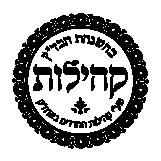
Premium delicious shabbes meals







Openning hours:

Thursday 12 pm-2 am
Friday 8 am-3 pm

100 TORAH TIDBITS 1511 / TZAV / SHABBAT HAGADOL - PESACH - SHEMINI
Shabbos Bistro
02-9964469 | 054-8777347 Iben Shafrut 5, Rehavia, Jerusalem



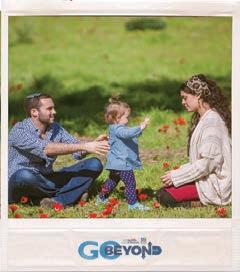
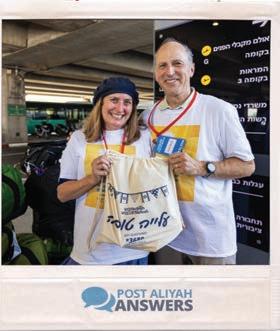
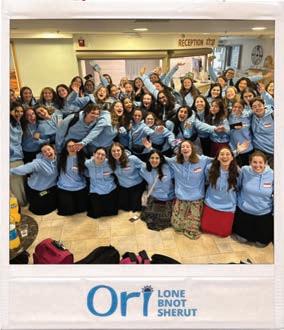




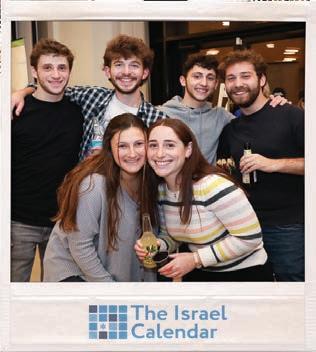

OU ISRAEL CENTER 101 FACILITATE • CELEBRATE • ADVOCATE • EDUCATE WORKING IN PARTNERSHIP TO BUILD A STRONGER ISRAEL THROUGH ALIYAH חספ גח !חמש Got Aliyah questions? We've got answers! *3680 answers@nbn.org.il
Real Life Rescues
Rishon LeZion Man Severely Injured While Pesach Cleaning, Saved by EMTs

Last Monday in Rishon LeZion, a man was cleaning his apartment in preparation for Pesach and inadvertently fell from a third-floor window of the building, causing himself serious injuries.

Eyewitnesses in the area said that they heard a loud noise and rushed to the scene to find the man lying on the ground in extreme pain. They immediately called emergency services for help and began administering first aid to the victim until the arrival of the first responder on the scene, United Hatzalah volunteer EMT Emmanuel Itzkowitz.
Emmanuel arrived within 3 minutes and found the injured man conscious and still screaming. The man had suffered a fracture in the left hand and had several signs showing that he was bleeding internally in numerous locations in his abdomen and pelvis.
Emmanuel radioed United Hatzalah’s dispatch center and requested backup while giving them a full explanation of the injuries the patient was suffering. Itzhak Shama, another United Hatzalah volunteer, arrived a few moments later on his ambucycle and assisted Emmanuel with the treatment.

Together, the two EMTs immobilized the man and bandaged his broken arm. When the mobile intensive care ambulance arrived, they helped the paramedics get the man on a stretcher and get him into the ambulance.
After the incident ended Emanuel explained what prompted him to become a volunteer. “I became an EMT back in 2018, when my daughter used to have convulsions, each time we used to call emergency services and wait for their arrival. I felt horrible seeing my daughter suffer and not being able to do anything until finally, I made up my mind to take a training course and become an EMT so that I could help her. I joined the United Hatzalah EMT course in order to save lives and help others quickly so that neither my daughter nor anyone else would have to suffer while waiting for an ambulance to arrive.”
Itzhak “When I was a little boy in Bnei Brak, I used to see United Hatzalahs EMTs coming and saving people, they always seemed like heroes to me. I saw the EMTs responding to many different emergencies, some even very difficult scenes, but they were always helping people and that is something I appreciated. I promised myself that when I grew up and had the opportunity, I would train and be just like them. I signed up to take an EMT course the first chance I could and since then, I have been responding to medical emergencies and thankfully have been able to help many people. I believe that this is the greatest thing that I can do”.
102 TORAH TIDBITS 1511 / TZAV / SHABBAT HAGADOL - PESACH - SHEMINI
1221
Heart-Stopping Drama. Heart-Warming Rescues.



OU ISRAEL CENTER 103 AVAILABLE ON AMAZON, ARTSCROLL.COM AND JEWISH BOOK STORES NEAR YOU! NEW! A MUST-READ BOOK FROM RABBI NACHMAN SELTZER! 90 Seconds is the story of how a boy who failed in school created Israel’s United Hatzalah, one of the world’s largest all-volunteer emergency service. It’s the story of dramatic rescues, sometimes under fire. Of life-changing and life-saving innovations such as the “ambucycle.” It is the story of how with determination, vision, self-sacrifice and compassion – and, of course, siyata diShmaya – lives can be saved and dreams can come true.
Heart-Lifting Inspiration.
SAVETHEDATE
The Beit Shemesh Community Beit Medrash Initiative in conjunction with YU Israel and Yeshiva University-RIETS is proud to invite the community to mark the 30th Yahrtzeit of Rav Yosef Dov Halevi Soloveitchik zt"l


Featuring many of the talmidim of the Rav and his family

THURSDAY, APRIL 13 7:00 p.m. at BMTL (1 Rechov Asher)
Rav Moshe Lichtenstein, Rav Meyer Lichtenstein, and Rav Avishai David
THURSDAY, APRIL 20
Location and speakers to be announced
FRIDAY, APRIL 28
Location and speakers to be announced
THURSDAY, MAY 4
8:00 p.m. • Location TBD Rav Aharon Adler

THURSDAY, MAY 11
Location and speakers to be announced

Other presenters to include Rav Aharon Rakefet, Rav Dovid Miller and other leading Roshei Yeshiva

104 TORAH TIDBITS 1511 / TZAV / SHABBAT HAGADOL - PESACH - SHEMINI
THE MOST SOUGHT AFTER LOCATION IN OLD KATAMON IN JERUSALEM


OU ISRAEL CENTER 105
Important seminar for South Africans in Israel

Wednesday 19th April - Tel Aviv 17:00

Program
Impact of SA Grey listing status on your funds

Tax issues affecting SA'n emigration & aliya
Gallery tour of Sotheby's exhibition

"Contemporary Redefined - Africa Today"
Conversation between Sotheby's director Sigal
Mordechai and Collector Michael Fessel
Light refreshments
Call
106 TORAH TIDBITS 1511 / TZAV / SHABBAT HAGADOL - PESACH - SHEMINI
02-992 1519








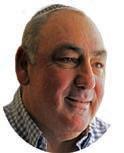

OU ISRAEL CENTER 107 OU ISRAEL CENTER 15 the the disdains successfully. with with He His name in Passover have to ourselves from your six? 02-651-4030 www.eifermanrealty.com It’s never too late to file prior years’ tax returns! 02-999-2104 | 09-746-0623 | 03-527-3254 052-274-9999 Email: alan@ardcpa.com www.ardcpa.com Trusted US/Israeli tax services for over 30 years • U.S. Income Tax Returns • Israeli Tax Returns • Foreign Bank Reports (FBAR) • IRS Audit Representation • IRS Streamlined Program • Corporate Tax Planning • Estate and Trust Tax Planning • $1400 U.S. Child Credit • Investment Planning • Bookkeeping Services • Other Accounting Services ד“סב Twice asNice f or Half the Price! ™ motti@mrashkelon.com | www.mrashkelon.com 054 7312118 It would be wrong to passover Ashkelon this Pesach Our teamwork will make your dream work ISRAVILLA IS AVAILABLE FOR PESACH. ACCOMMODATES 50+, HEATED POOL, TOTALLY SECLUDED QUIET EXPANSIVE ESTATE. ISRAVILLA.COM (for guest feedback, see Google Maps Isravilla)


108 TORAH TIDBITS 1511 / TZAV / SHABBAT HAGADOL - PESACH - SHEMINI
The OU Israel Center is looking for a AN EXPERIENCED
GRAPHIC DESIGNER For a part time position
Experience with Adobe Programs
Indesign, Illustrator and Photoshop
Creative | Attention to Detail | Easy Going
Background in Magazine Layout
Able to work under pressure
To apply, please send CV to Sara atsarab@ouisrael.org

Exclusive to Haas Realty In Arnona

Efrata Street, 4 rooms, 90-meters with Sukkah balcony, first floor, quiet, shared parking and storage. Great investment.

Asking Price: 2,975,000 NIS
For details: Aliza Haas; Tel: 0502991737
OU ISRAEL CENTER 109










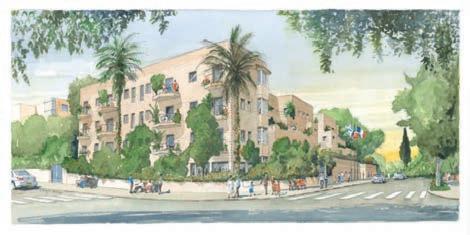





110 TORAH TIDBITS 1511 / TZAV / SHABBAT HAGADOL - PESACH - SHEMINI 27 KOREH-HADOROT ST., JERUSALEM NEVE.SHALEM @GMAIL.COM | WWW.NEVE-SHALEM.CO.IL BOUTIQUE RESIDENCE FOR SENIORS IN THE LUXURIOUS NEIGHBORHOOD OF ARNONA, JERUSALEM NEVE SHALEM IS AN ASSISTED LIVING FACILITY FOR RETIREES AND SENIORS WITH 60% ENGLISH SPEAKERS! Full calendar of activities and entertainment in English and Hebrew! Quality apartments built to high standards with balconies & gardens Professional medical services A dedicated staff providing for all the needs of our senior citizens 24/7 - Just like family! *3204 SINCE 1995 IMMEDIATE OCCUPANCY 2.5 ROOM APARTMENT + PORCH
ONLT 4 DAYS TO GET FREE GIFT & BEFORE FILM PRICES GO UP
A BARBANEL

A MAN OF MANY WORLDS
SUNDAY EVENING, APRIL 16, 8:00 PM
in the Pelech Girls school – 31 Yehuda St., Baka but ONLY by prior registration and payment
Cost: 100 NIS per person
Ifyou registerbeforePesach,(April5)you’ll receivea Destinygiftworth100NIS!Prices rise afterPesach
SPECIALPRE-PESACHOFFER: PAY FOR TWO ADULT TICKETS AND YOU CAN BRING AS MANY MEMBERS OF YOUR FAMILY (9-99) FOR FREE!!! (Payment and names must be submitted before Pesach)
BECOME A DESTINY SPONSOR OF THE PREMIER AND SUPPORT RABBI WEIN & DESTINY

best seats, light dinner and meet with Rabbi Wein before the film 500 NIS per couple
For ques tions, sign up form s , information, p ayment , email Shir a at abarba nel movie@gmail.com or WhatsApp 0547 - 54 - 36 -18
SHAVUOT RETREAT
in the magnificent, mostKosher (HashgachaMehadrinRabbanutGalilTachton,RabbiRubinMeat)
LAVI HOTEL
FEATURING RABBI BEREL WEIN AS SCHOLAR IN RESIDENCE (& additional Rabbis)
Five days and Four Nights, Wednesday, May 24 through Sunday, May 28 (Shavuot begins Thursday night)
PRIVATE DINING ROOM, BUFFET & FOR DESTINY GUESTS
Seven Lectures & Shiurim by Rabbi Wein
Full board throughout, outstanding cuisine of highest Kashrut Standard
All night English Shavuot Program with Rabbi Wein, Rabbis & refreshments
Total Torah atmosphere in the hotel, renowned Lavi hospitality
EARLY - BIRD DISCOUNT for those paying in fu ll befo re (1 st da y of ) Pesach
FREE TIYUL or F REE BUS to & from hotel (580 NIS e quivalent)
For registration forms , prices and all questions , call Nachum Amsel at 0522-52-00-31 or write to nachum@jewishdestiny.com
OU ISRAEL CENTER 111





info@jmarkinteriors.com jmarkinteriors.com jmarkinteriors jmarkjerusalem/jmarkinteriors ARCHITECTURE DESIGN PROJECT MANAGEMENT 22 King David Street Jerusalem Israel 94101 02.803.8881 (From USA +1.646.461.3510) 461 Central Avenue Cedarhurst New York 11516 +1.516.295.0856 WISHING ALL OF OUR CLIENTS A HAPPY PESACH!
Photos:
Alon Barhom


































































































































































































































































 Dr.
Dr.




































































































































































































